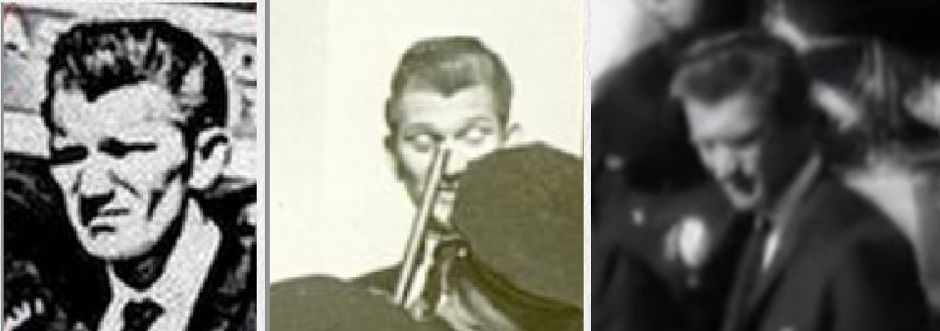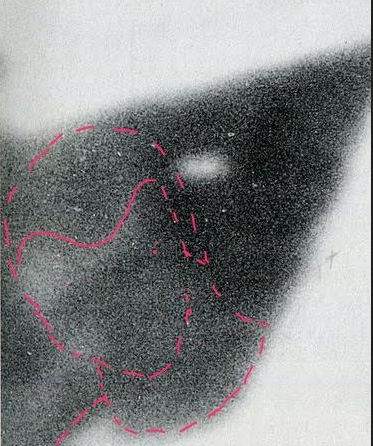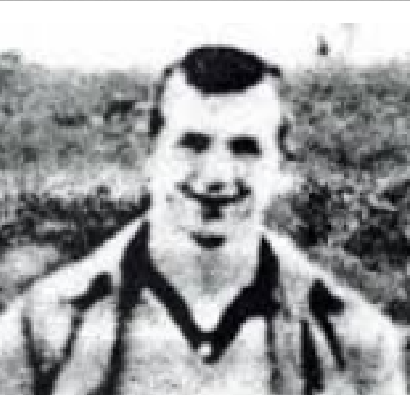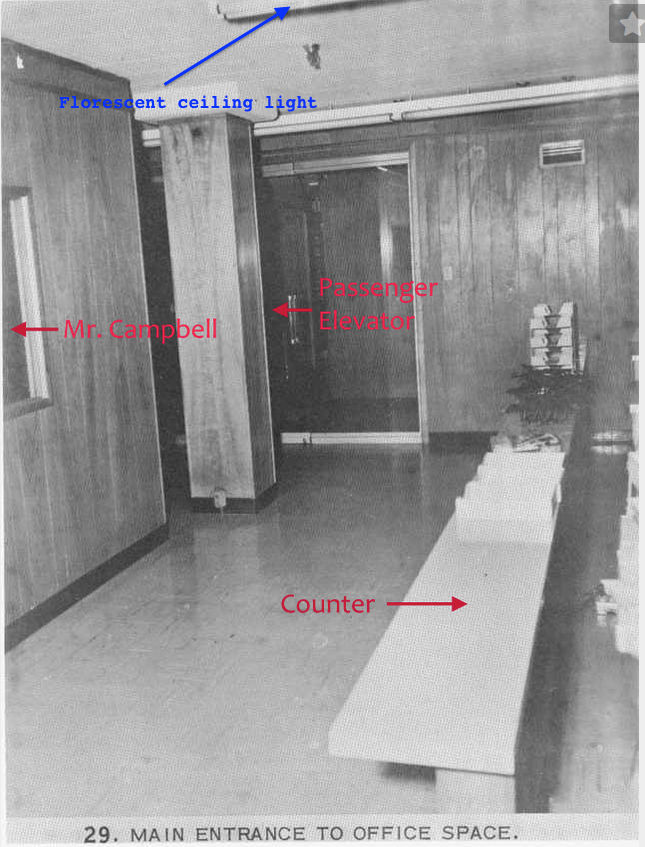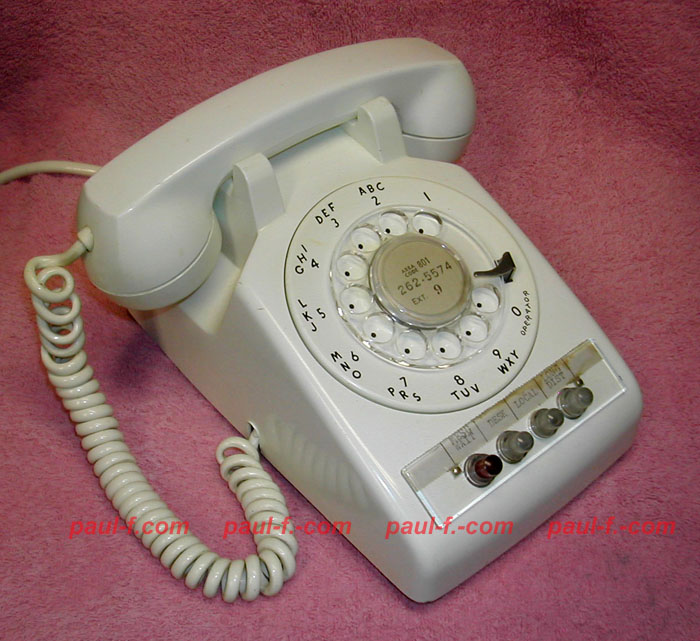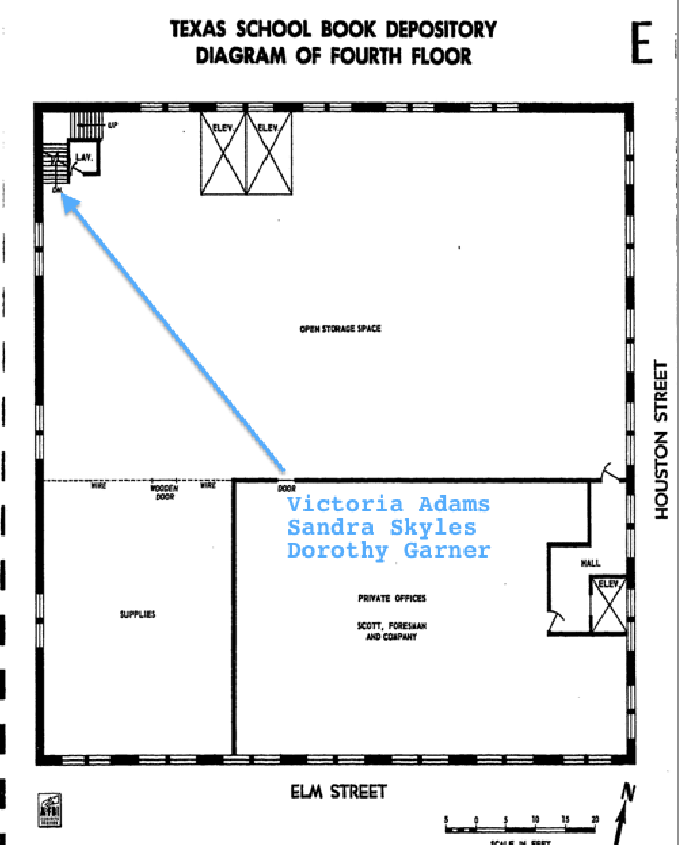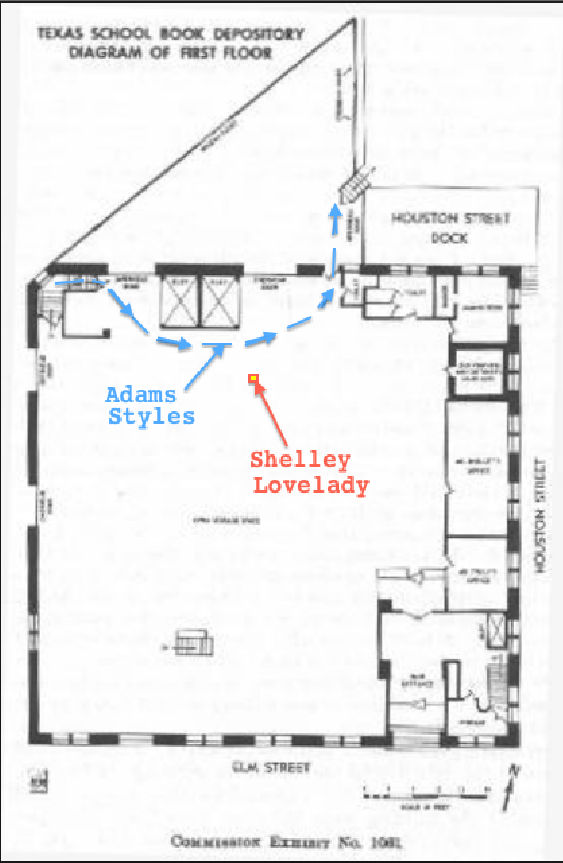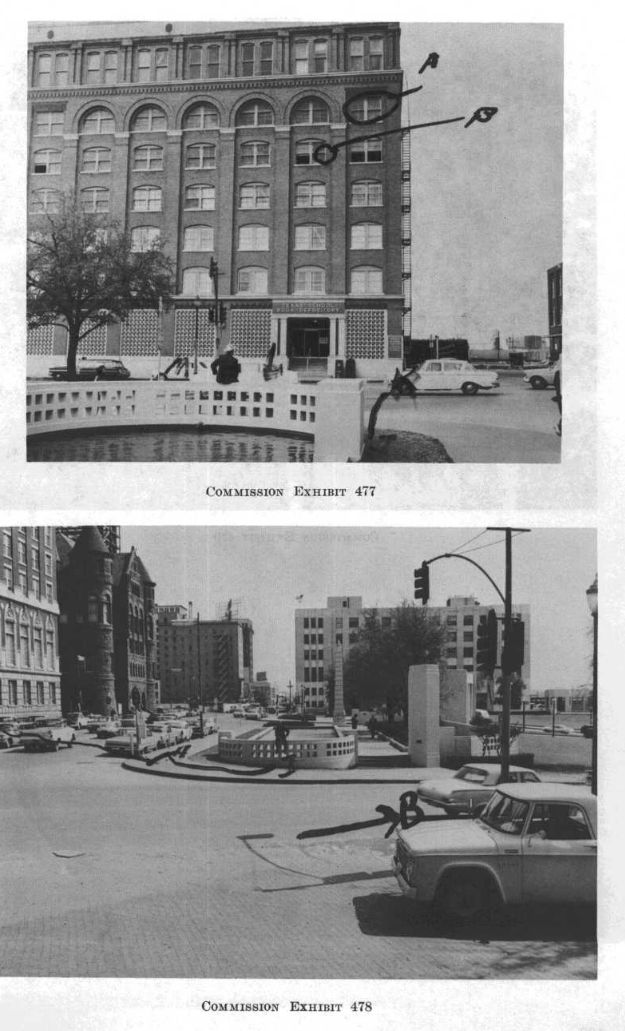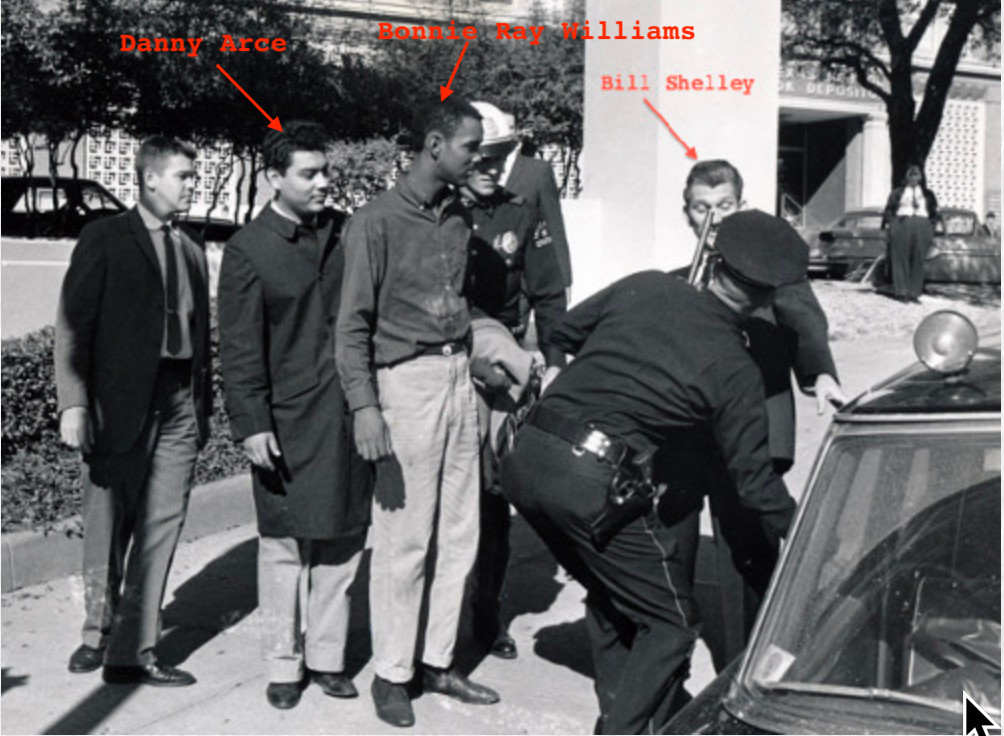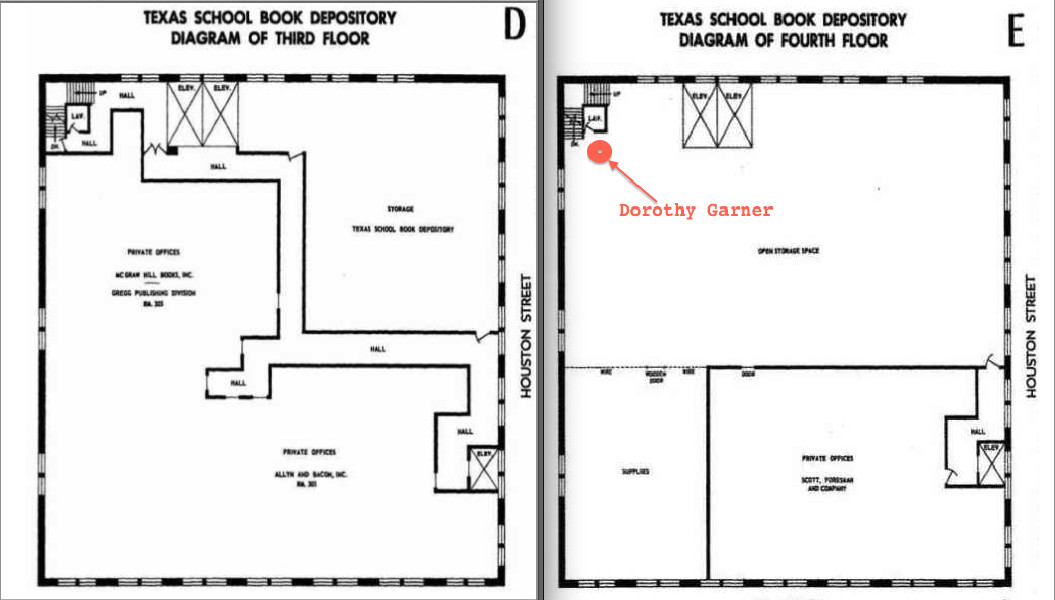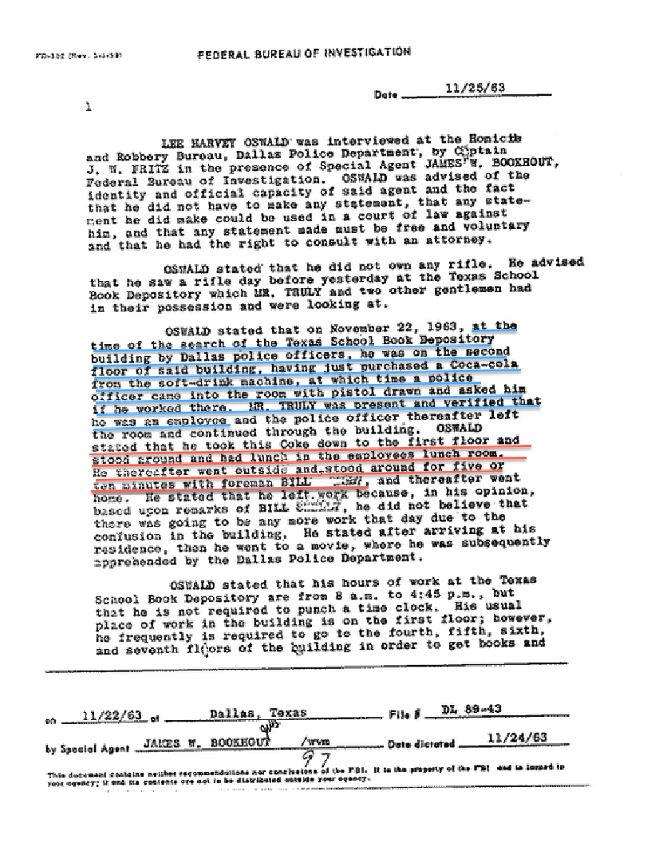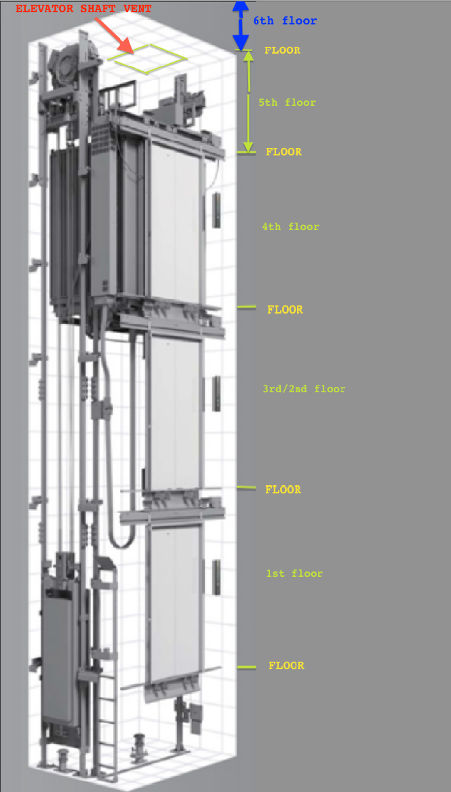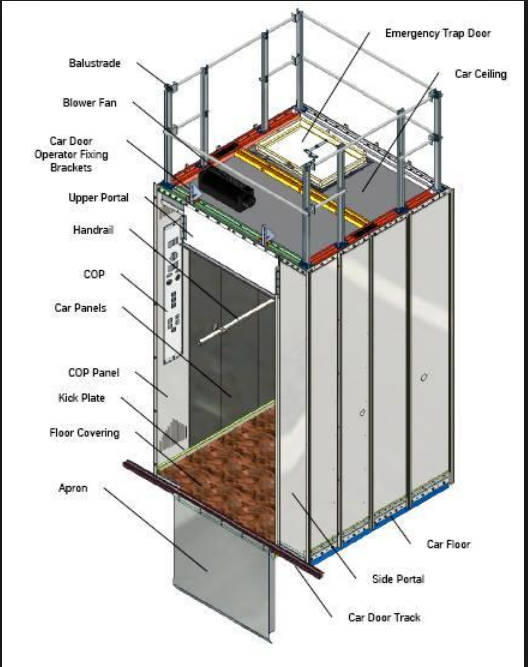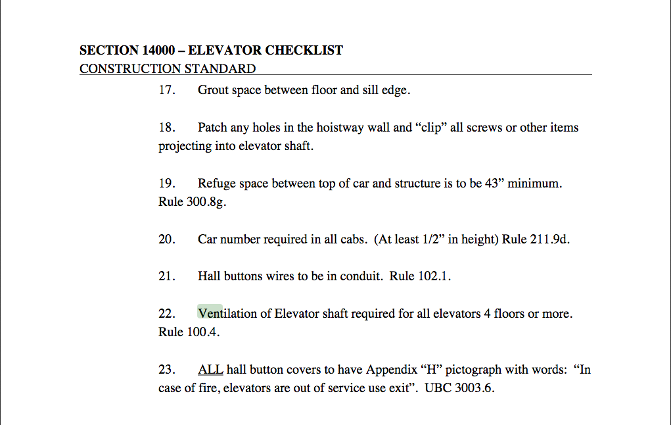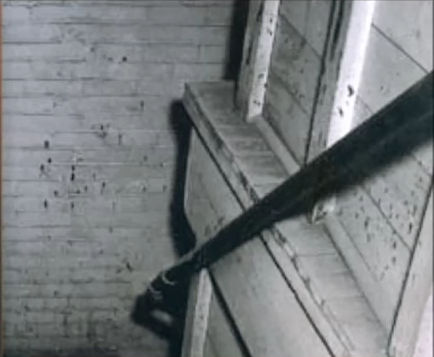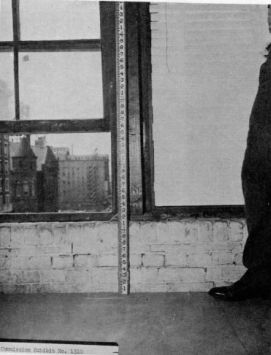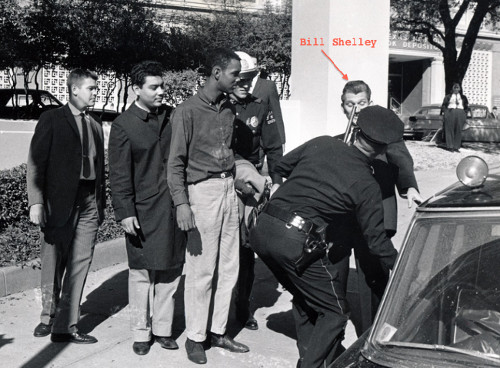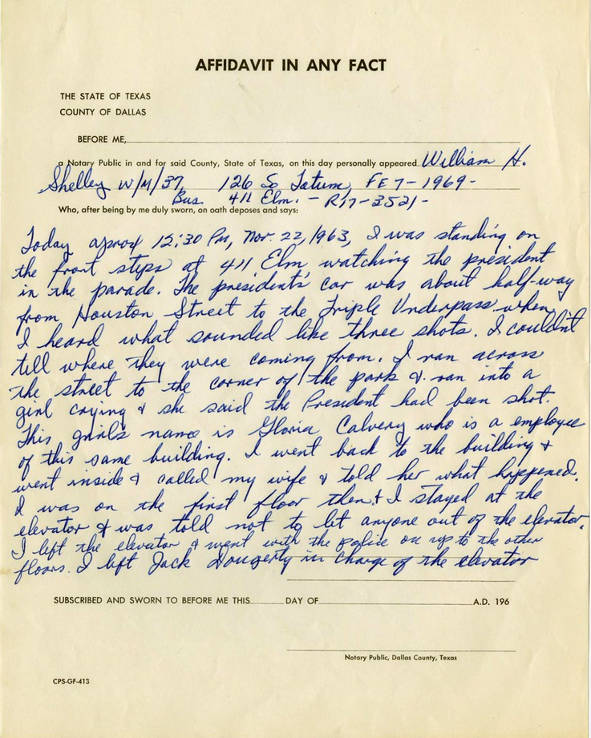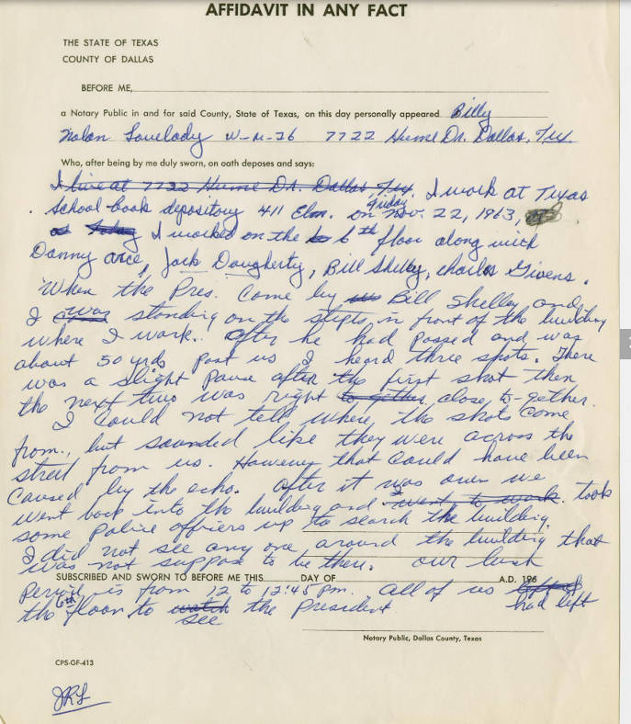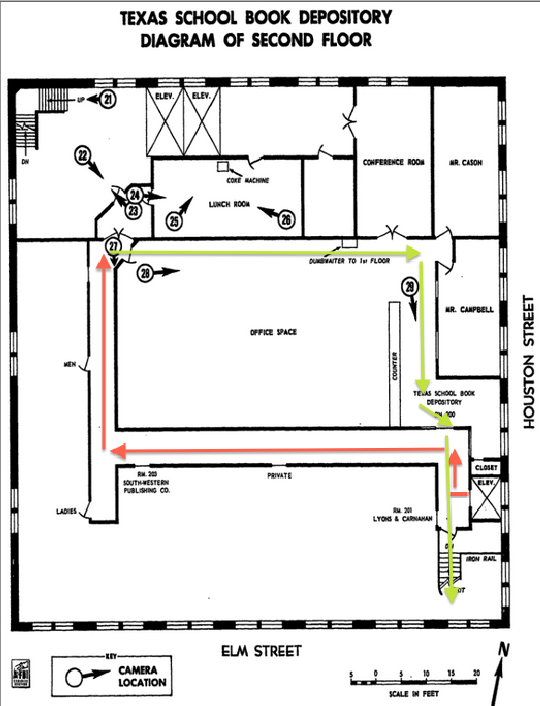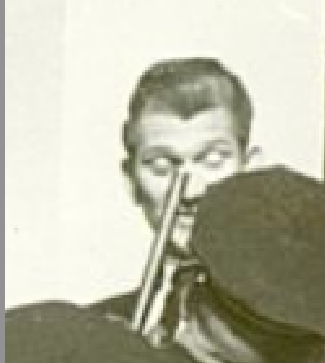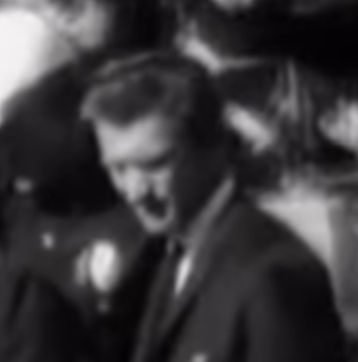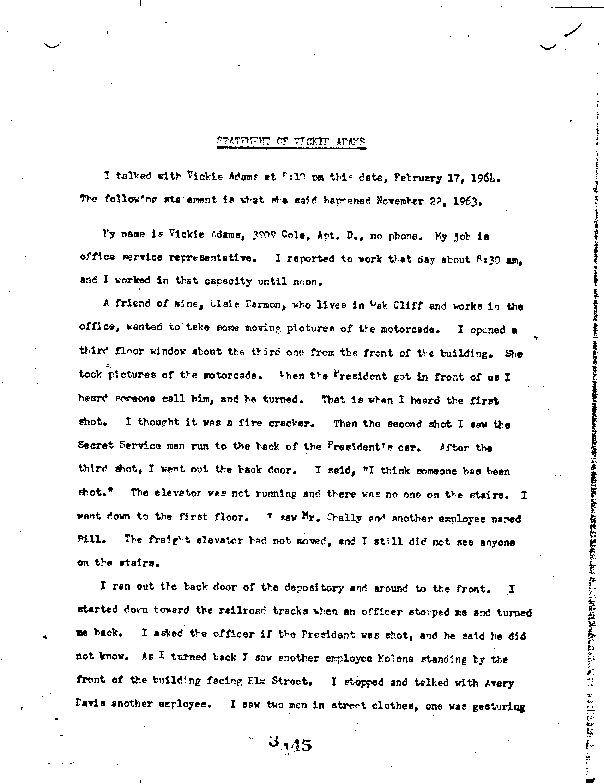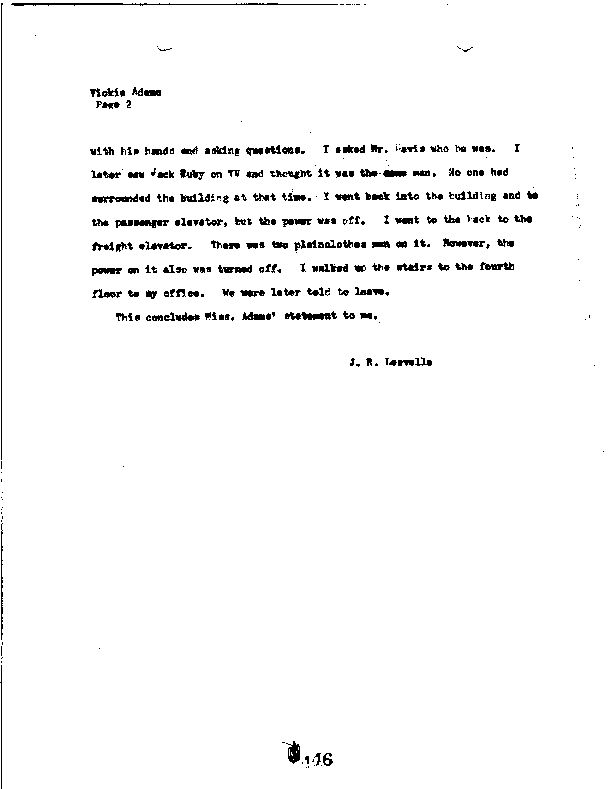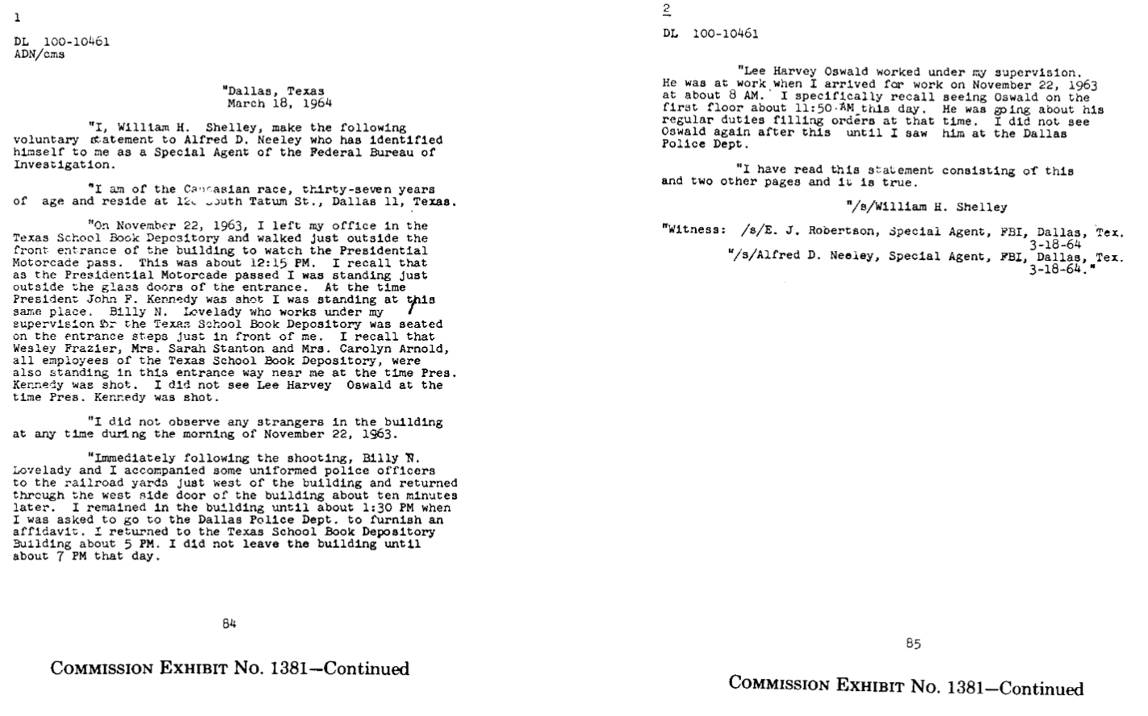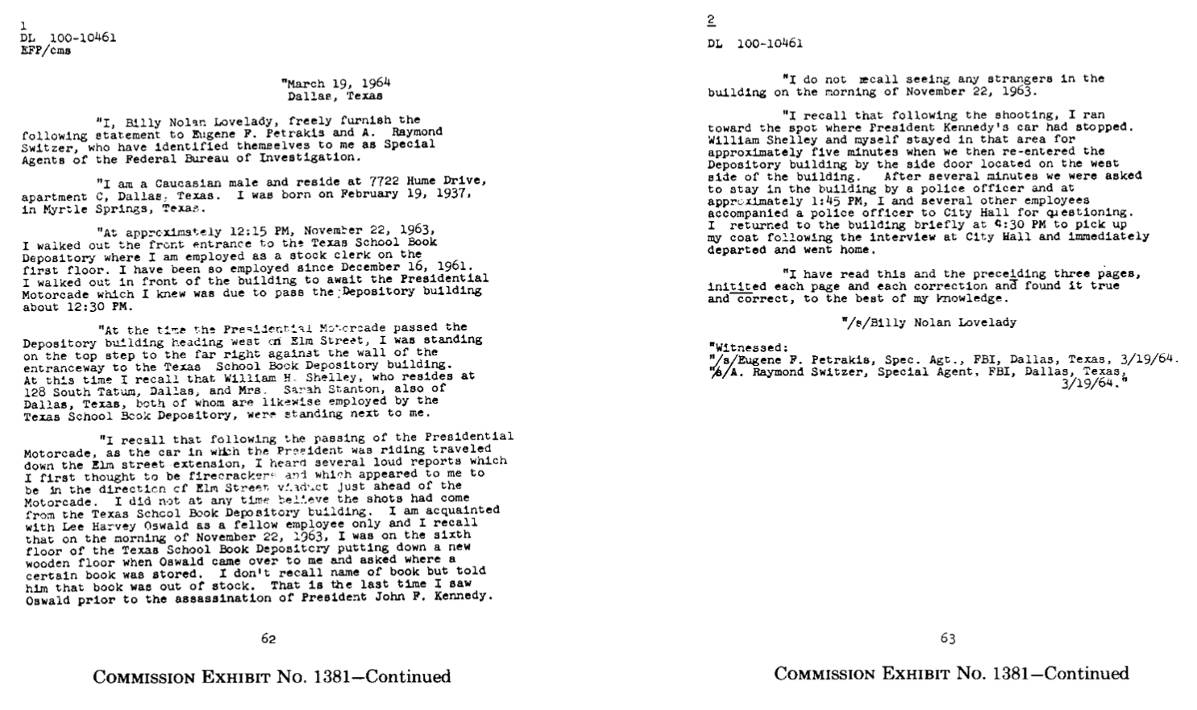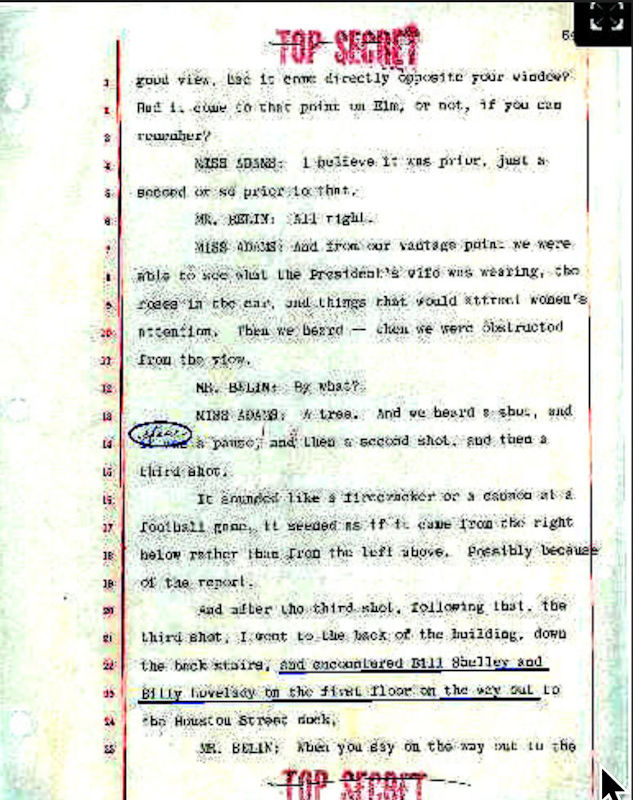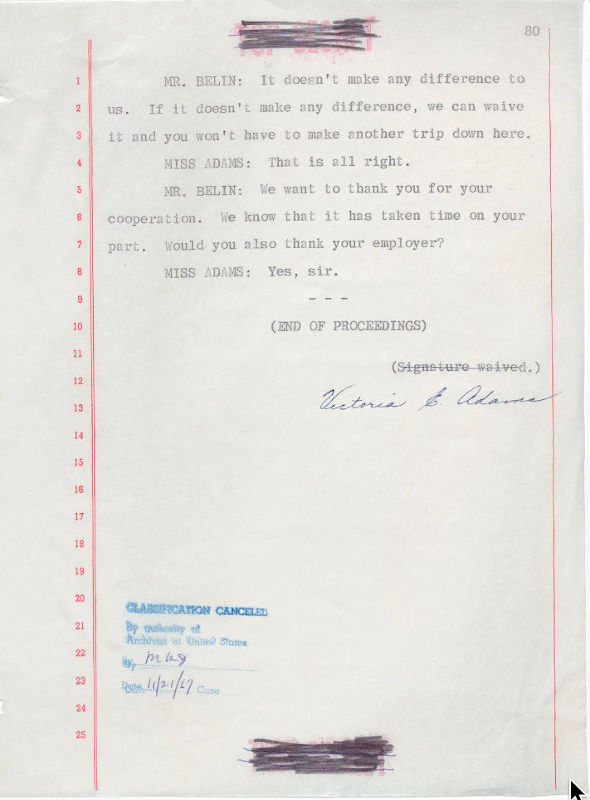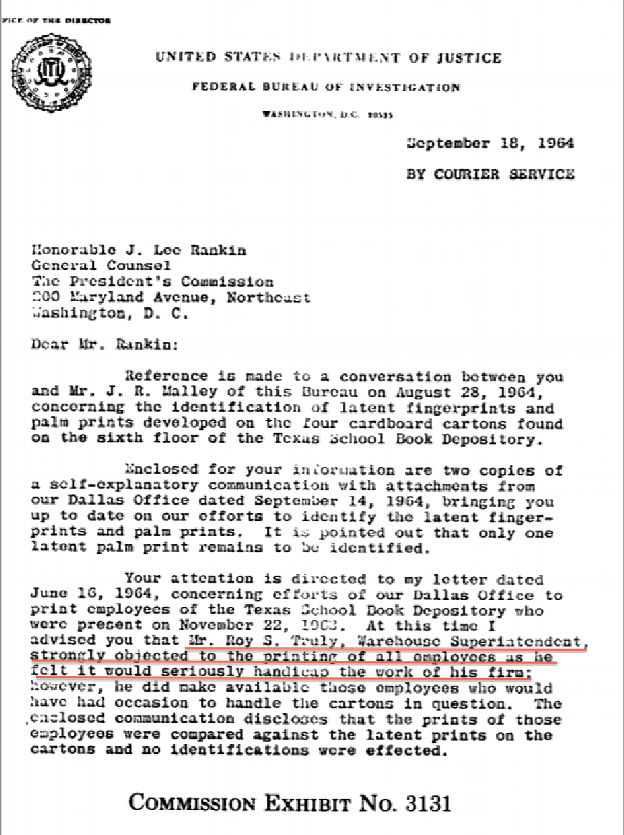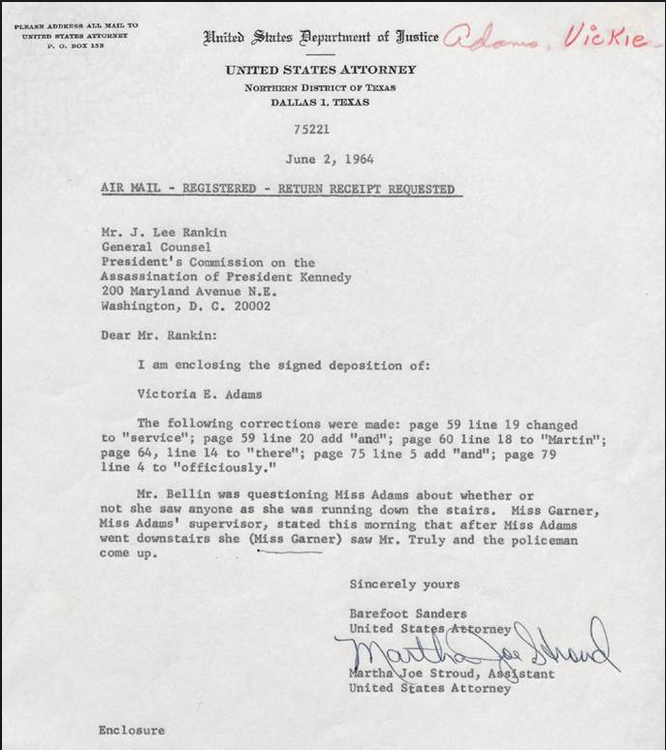From
the last shot fired at President Kennedy, it had taken Baker between a
minute and fifteen seconds and a minute and thirty seconds to park his
motorcycle, meet up with Roy Truly at the entrance to the the building,
and arrive at the
freight elevators at the back of the building. BAKER AND TRULY
ARRIVED AT THE
FREIGHT ELEVATORS ONLY MOMENTS AFTER VICTORIA ADAMS AND SANDRA STYLES
ARRIVED ON THE FIRST FLOOR (ONE MINUTE AFTER SHOTS WERE FIRED) AND THEN
HURRIED OUT THE BACK DOOR OF THE BUILDING. Truly pushed the
elevator call button but the neither the east nor west elevators
responded (the electricity was off). Truly looked up the elevator shaft
and saw that both elevators were on the 5th floor. Truly then began
running up the old wooden stairs, with Officer Baker following. He ran
up to the second floor and was beginning to run up to the 3rd floor
when Officer Baker saw a man "walking away from the stairway." Later
that afternoon Baker gave an affidavit to the DPD and said, "I called
to the man (HARVEY Oswald) and he turned around and came back toward
me. The building manager said, 'I know that man he works here.' I
turned the man loose and went up to the top floor."
Warren Commission member Senator Sherman Cooper wanted to know if
Officer Baker saw or heard anyone on the 3rd, 4th, 5th or 6th floors....
SENATOR COOPER - Anyway, as you walked up the stairs
could you see into each floor space as you passed from floor to floor?
Mr. BAKER - Partly. Now, this building has got pillars in it, you know,
and then it has got books, cases of books stacked all in it. And the
best that I could, you know, I would look through there and see if I
could see anybody.
SENATOR COOPER - Did you see anyone?
Mr. BAKER - No, sir.
SENATOR COOPER - When you looked?
Mr. BAKER - Not from the second floor on up.
3RD OR 4TH FLOOR? In Baker's original affidavit he said that
he encountered (HARVEY) Oswald on the 3rd or 4th floor. Baker, who was
unfamiliar with the TSBD, may have thought that after climbing the
stairs to enter the TSBD that he was on the 2nd floor of the TSBD
building instead of on the 1st floor. This could be the reason, after
climbing up the wooden stairs in the NW corner of the building, that he
thought he encountered (HARVEY) Oswald on the 3rd or 4th floor.
However, the encounter with (HARVEY) Oswald could not have happened on
the 3rd floor (below, left), as the only area between the two sets of
stairs is a very small, narrow hall with no door visible, no lunch
room, no coke machine. The encounter with (HARVEY) Oswald could also
not have happened on the 4th floor because Dorothy Garner watched
Vickie Adams and Sandra Styles hurry down these stairs, and then Ms.
Garner remained standing by the stairway (lower, right) and watched Roy
Truly and Officer Baker as they ran past her and went up to the 5th
floor. It is important to
remember that
within 15-20 seconds after the last shot was fired, supervisor Dorothy
Garner was standing by the stairs, and remained standing by the stairs
while Baker and Truly ran past her and up to the 5th floor. During this
time, nobody from the 5th or 6th floors could have hurried or run down
these old, wooden stairs, nor ridden down the west freight
elevator without being heard and seen by Ms. Garner.
BAKER'S CONFIRMATION OF THE LUNCHROOM ENCOUNTER: On the
afternoon of 11/22/63 Detective Marvin Johnson, DPD #879, took an
affidavit from Officer Marrion Baker. Johnson described in a memo how
Officer Baker, while sitting for his affidavit, saw Oswald after he
(HARVEY Oswald) was brought to the police station. Det. Johnson wrote:
"Patrolman Baker was in the Homicide Bureau giving an affidavit and
(HARVEY) Oswald was brought into the room to talk to some Secret
Service men. When Baker saw Oswald he stated, 'that is the man I
stopped on the 4th floor of the School Book Depository.'"
OSWALD'S CONFIRMATION OF THE LUNCHROOM ENCOUNTER: When Capt.
Fritz interviewed (HARVEY) Oswald for the first time, beginning at 3:15
PM, he
wrote notes of Oswald's responses/answers to his questions. In relation
to the lunchroom encounter Fritz wrote, "claims 2nd floor coke when
off came in...to 1st fl...had lunch out with Bill Shelley in front."
OFFICER BAKER AND (HARVEY) OSWALD, ONLY A FEW HOURS AFTER
PRESIDENT KENNEDY
WAS MURDERED, INDEPENDENTLY CONFIRMED THEIR LUNCHROOM ENCOUNTER.
TIMING SEQUENCE: The
Warren
Commission recorded the time it took Officer Baker and Secret Service
agent Howlett to run from the SE corner of the building to the 2nd
floor lunchroom--between one minute fifteen seconds and one minute
eighteen seconds. It is very clear that one or more shooters from the
6th floor could not have ran down the stairs nor rode the west freight
elevator past the 4th floor without being seen by Dorothy Garner nor
seen nor heard by Garner, Adams, Styles, Baker, or Truly. The man
confronted by Officer Baker in the lunchroom, 1 1/2 minutes after the
shooting, was alone and was already in the lunchroom before the shots
were fired, when the shots were fired, and moments after shots were
fired at President Kennedy.
On the 4th floor, only moments after shots were fired, supervisor
Dorothy Garner watched Victoria Adams and Sandra Styles run down the
stairs to the first floor. Two minutes later she watched Baker and
Truly as they ran past her on the 4th floor and continued running up
the stairway. At the same time TSBD employee Geneva Hines returned to
her office on the 2nd floor and saw the ceiling lights in her office
and the lights on her 3-line telephone were now working. Within
one to two minutes after President Kennedy was shot, the electricity
was turned back on, while at the same time Baker and Truly were running
from the 1st to
the 5th floor. Now, all three elevators in the TSBD could be used
(2 freight elevators and the passenger elevator).
NOTE: All but two of the warehouse workers were
laborers, and their work consisted of receiving bulk shipments of books
from dozens of companies, sorting and storing those books on floors 5
and 6, and then filling customer orders by locating specific school
books, and then taking those books to the 1st floor, where they were
boxed, wrapped, and shipped. There were two supervisors in charge of
the laborers--Roy Truly and Bill Shelley. Following the shooting, Truly
was with Officer Baker on the upper floors of the TSBD. Only one
supervisor, Billy Shelley, was on the 1st floor and had the motive,
means, and opportunity to turn the electricity on, and off, in the
building.
After turning on the electricity (circa 12:32-33 PM) the two men on the
first floor (Shelley/Lovelady) began walking toward Shelley's office.
At the same time it appears that HARVEY Oswald entered the warehouse
thru the double doors and began talking with Shelley. At the same time
NBC newsman Robert MacNeil (circa 12:34 PM) entered the warehouse thru
the double doors, and saw three "very calm men." MacNeil asked for the
location of a telephone (probably the phone in Roy Truly's office),
waited briefly for an open line, and called his office in New York City
(time recorded at 12:36 PM). It appears that Shelley and/or
Lovelady may have then returned to the front steps of the TSBD with
fellow employees.
QUESTION: Only ONE MINUTE
after shots were fired at President Kennedy, what possible, legitimate
reason could Bill Shelley and Billy Lovelady have for being at the rear
of the building? The electricity was turned back on when these two men
were on the first floor near the electrical panels. If neither Shelley
nor
Lovelady turned on the electricity, then who did?
When Baker and Truly reached the 5th floor a policeman (Baker) was seen
by three TSBD employees--Junior Jarman, Harold Norman, and Bonnie Ray
Williams. When Truly noticed that the west elevator had moved,
indicating the electricity had been turned back on, Baker and Truly
then got on the east freight elevator and rode up to the 7th floor.
NOTE: We should remember that as Roy Truly and
Officer Baker were running up the stairs they were passing by offices
and office space that occupied the 2nd, 3rd, and 4th floors of the
building. On the 5th floor, by choosing to ride the east freight
elevator to the 7th floor, Roy Truly prevented Officer Baker from
setting foot on the 6th floor. Whether this was intentional or
unintentional, Truly's decision to ride the freight elevator denied
Officer Baker the opportunity to visually scan, observe, or perhaps see
movement in 6th floor warehouse area, similar to Baker's observing the
movement of HARVEY Oswald on the 2nd floor.
The two men on the 6th floor suddenly disappear
In 1963 there were only three ways for people to get from the 1st
floor to the 5th, 6th, and 7th floor warehouse areas. #1--There were
two freight elevators at the rear of the building, but they could only
be used if the electricity was on. #2--There was an old wooden enclosed
stairway at the rear of the building. #3--There was a fire escape on
the outside of the building. The new passenger elevator, located near
the front entrance to the building on Elm and Houston Streets, serviced
only the 1st, 2nd, 3rd, and 4th floors.
#1--the freight elevators. A minute after the shooting Officer
Baker
and Roy Truly were on the first floor, at the rear of the TSBD,
standing by the two freight
elevators. Both elevators appeared to be stopped in place on the 5th
floor, and did not respond when Truly pushed the call button for an
elevator. The elevators were not working because the electricity was
shut off. If the electricity were on, and anyone were to ride one
of these slow moving freight elevators from the 6th to the 1st floor,
they would first have been seen by Dorothy Garner, who was standing by
the stairway on the 4th floor. If someone had ridden one of the
elevators from the 6th floor down to the 1st floor, then that same
elevator would have to travel back to the 5th floor by the time Truly
and Baker arrived. In other words, one of these slow moving, noisy,
freight elevators would have to travel from the 6th floor to the 1st
floor, and then return to the 5th floor within one minute, which
was
impossible. Therefore, the two men on the 6th floor could not possibly
have ridden either of the slow moving freight elevators to the 1st
floor (escape route #1).
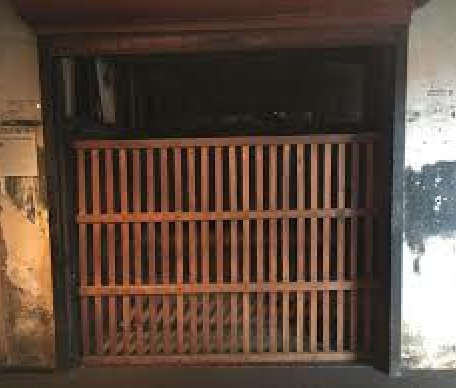
|
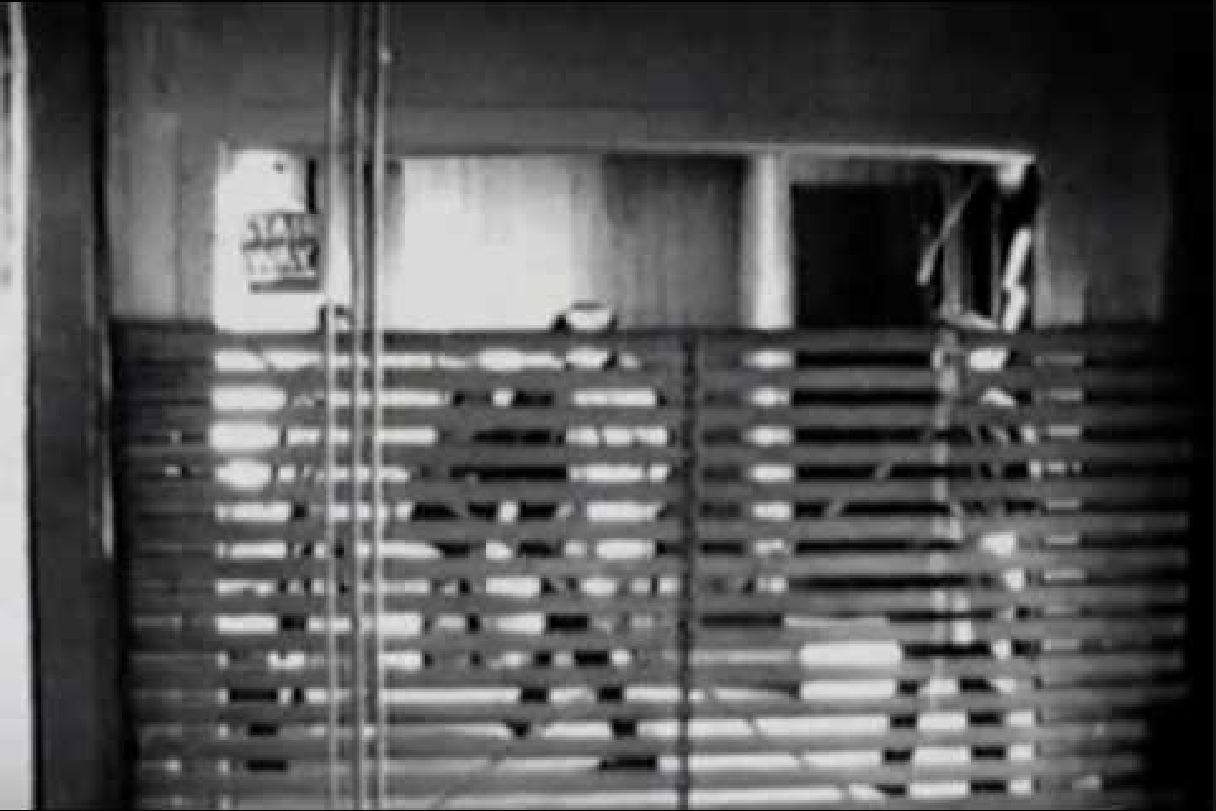
|
East freight elevator
|
Photo taken while standing
inside
of the west freight elevator
|
#2--the
old wooden stairway. The first people to use the NW stairway
following the shooting were Victoria Adams and Sandra Styles on the 4th
floor. These two young women were running down the stairs to the first
floor as Officer Baker was parking his police motorcycle at the corner
of Elm and Houston. Baker looked around and told the Warren Commission
"there were people running all over....500-600 people in this area."
Baker hurried thru the crowd to the entrance of the TSBD, up the
stairway, and into the building. Inside the lobby he shouted, "Where
are the stairs?" Roy Truly, the building manager, introduced himself
and said, "I am a building manager, follow me." Shoving people aside,
the two men hurried thru the double doors, into the warehouse, past
Bill Shelley's office, past Roy Truly's office, and arrived at the
northwest
corner of the building only moments after Victoria Adams and Sandra
Styles left the building thru the rear door (onto the loading dock). As
Truly pushed the elevator call button and shouted for an elevator,
Officer Baker looked around and saw two men nearby. Baker told the
Warren Commission, "On the first floor there were two men. As we came
through the main doorway to the elevators, I remember as we tried to
get on the elevators I remember two men, one was sitting on this side
and another one between 20 or 30 feet away from us looking at us." WC
member Allen Dulles asked, "Were they white men?" Officer Baker
replied, "Yes, sir."
If these two "white men" were strangers, unknown to Roy Truly, then why
did Truly not confront them and ask what they were doing in the TSBD?
The fact that Truly said nothing to these men and nothing to Officer
Baker is a good indication that he knew both of these men--in
particular Bill Shelley who worked directly under Truly. It is
interesting to note that Officer Baker was interviewed by W.C. attorney
David Belin on March 20, 1964. Belin knew there were two unidentified
"white men" at the back of the TSBD, only one minute after the
shooting. But when Belin interviewed Roy Truly a few weeks later, he
never questioned Truly about these two men, nor did Truly say anything
about these two men. Why not?
Officer
Baker and Truly, with Truly leading the way, began to run up the old
wooden stairway. Baker caught a glimpse of a man on the 2nd floor and
confronted him (this was HARVEY Oswald--long sleeve brown shirt).
After Truly told Baker the man
was an employee the officer turned away and the two men continued
running up the stairs. When interviewed on 11/22/63 by FBI agent James
Bookout, Oswald described the confrontation with Officer Baker and
Truly.
Moments after confronting HARVEY Oswald in the 2nd floor lunchroom
Baker and Truly continued up the stairs and were seen on the 4th floor
by Dorothy Garner, who moments before had watched her two young office
workers, Vickie Adams and Sandra Styles, as they ran down the stairs.
While Baker and Truly were climbing the stairs someone turned on the
electricity, probably one of the two men seen by Officer Baker,
standing "20 or 30 feet away from us," near the electrical panels on
the first floor. After arriving on the 5th floor, Baker and Truly rode
the east freight elevator up to the 7th floor, and conveniently
bypassed the 5th and 6th floor warehouse areas. The west elevator had
been moved down to a lower floor.
Moments after the last shot was fired Adams, Styles, Baker, and Truly
were running up and down the old wooden stairs and neither saw or heard
anyone else on the stairway. The two men seen on the 6th floor could
not have used the old wooden stairs (escape route #2).
#3--the fire escape. The only other way of getting from the
6th to the
1st floor was the fire escape on the outside of the building on Houston
St. But if anyone had been on this fire escape following the shooting,
many people would have seen them and they likely would have been
photographed. The two men on the 6th floor did not use the fire escape
(escape route #3).
For years I wondered why so many people never heard nor saw anyone
running across the 6th floor, hurrying down the old wooden stairway, or
riding down on one of the freight elevators. Not one of these people
saw or heard anyone on the stairs or elevators. How was this possible?
How did 2 adult men vanish from the 6th floor? Nobody knows for
certain. But what is certain is that they did not use the freight
elevators, the old wooden stairway, or the fire escape.
Passenger elevator
The purpose of this essay is not to "prove" how two men vanished from
the 6th floor. My purpose is to show researchers that there is at least
one alternative "escape route." By using one plausible "escape route,"
which I will explain, we may be able to understand the reason why the
electricity was briefly turned off, why the 3 men on the 5th floor
heard nobody run across the 6th floor to the stairway, why neither the
3 men on the 5th floor (Jarman, Williams, Norman) or the lady office
workers on the 4th floor (Styles, Adams) saw
anybody running down the stairway or riding the freight elevators, and
why Officer Baker and Roy Truly saw nobody on the freight elevators or
stairway. What follows is an alternate, and very discreet and
secret
way by which to go from the 6th floor to the 1st floor. I BELIEVE THE 2
MEN ESCAPED FROM THE 6TH FLOOR BY USING THE PASSENGER ELEVATOR.
The passenger elevator is close to the main entrance of the building,
and carried people from the 1st to the 4th floors. The elevator shaft,
in which the elevator cabin moved from floor to floor, extended from
the basement thru the 5th floor. The mechanical equipment, including
cables, pulley's, gears, etc. was housed on the 5th floor (see
diagram
below). The Warren Commission published diagrams of all floors of the
Book Depository. Access to the passenger elevator is shown on the 1st,
2nd, 3rd, and 4th floor diagrams. But diagrams for the basement and 5th
floors show only the elevator shaft, with no public access at these
levels.
Below is a diagram that shows the 1st, 2nd, 3rd, and 4th floors of a
typical cable operated elevator. In this diagram the elevator is
stopped on the 4th floor, with the mechanical equipment directly
overhead on the 5th floor. It is very important for researchers to
understand, and remember, that the wooden boards on the ceiling of
the 5th floor elevator shaft are the floor boards for the 6th floor.
I'll say it again: "The wooden boards on the ceiling of the 5th
floor elevator shaft are the same wooden floor boards for the 6th
floor." By simply
lifting a few of these wooden boards, a person can climb onto the 6th
floor. And these wooden ceiling/floor boards are only about 15 feet
from the snipers nest on the 6th floor.
Building codes in the 1970s (found on-line) required elevators that
serviced 4 or more floors to be vented (see #22 below), due to the
large volume of air displaced as the elevator moved between floors.
Vents were typically placed at the top and bottom of the elevator shaft
(see diagram below). Building codes in many localities also required
that elevator shafts have wall mounted ladders, which were routinely
used by workers for maintenance.
All floors in the Book Depository were constructed with solid,
thick, wooden floor boards (single floor construction). The photo on
the right, of the stairway, shows the size and shape of the wooden
floor boards which were laid side by side. They appear to be 2" by 6"
solid wood boards. The photo below shows the size and shape of the wood
floor boards which were laid side by side.
The photo below shows the same 2 x 6 wooden boards on both the floor
and the
ceiling, extending from girder to girder. It
is important to understand and remember that in the Book Depository the
wooden ceiling boards on one floor are the wooden floor boards for the
next level.
We are focused on the 6th floor, on the area directly above the 5th
floor passenger elevator shaft which is only about 15 feet from the
snipers nest. If an air vent were installed in the ceiling of the 5th
floor elevator shaft, it would allow air to flow from the open elevator
shaft directly into the 6th floor (see diagram below). An air vent
would also provide direct access from the 5th floor to the 6th floor.
If an air vent were not installed in this area, then lifting a few 2 x
6 wood floor boards would provide the same direct access from the 5th
floor
to the 6th floor.
SUPPORTING WOOD BEAMS
The first two large wooden beams on the east side of the building,
which
support the 2" x 6" wooden floor/ceiling boards, are only 30" to 36"
apart.
Access between the 5th floor elevator shaft and the 6th floor would be
a simple matter of lifting only a few wooden boards (30" to 36" long),
as seen in the
photo below.
6th floor ingress (access to the 6th floor)
The passenger elevator, near the entrance to the TSBD ran from the
basement to the 4th floor. The elevator shaft, built solidly around the
passenger elevator, rose from the basement to the ceiling of the 5th
floor. On the 5th floor, above the
elevator cabin, were the pulleys, cables, electrical connections, etc
that were part of the mechanical controls that moved the elevator from
floor to floor. Access to the elevator shaft from the 5th floor was
available thru a locked door, but only to the maintenance crew. There
was no public access to the elevator shaft on the 5th floor. The small
caption on the photo below reads, "NO OPENING TO ELEV SHAFT ON THIS
FLOOR."
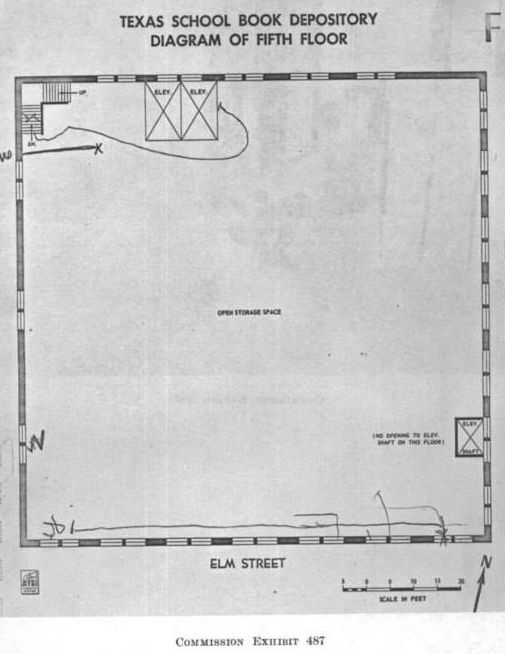
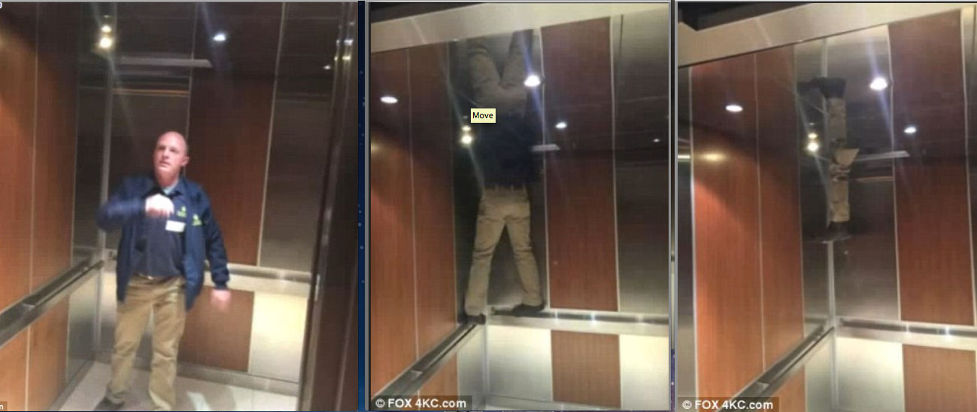
On
the top of elevator cabins was a permanently installed "car-top
station" (elevator talk/terminology) that contained electrical switches
and controls that could be used to move the elevator cabin both up and
down, and from floor to floor, while on top of the cabin. These panels
have been installed on elevators since the 1940's and are used by
maintenance crews.
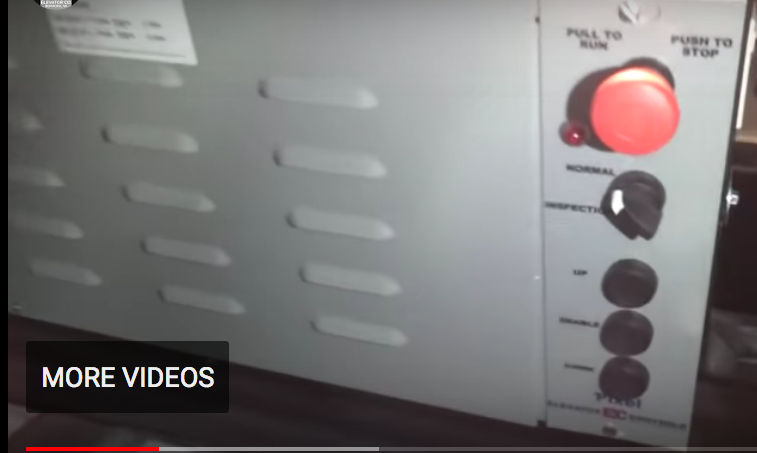
- "Car-top station" control panel
- One or more people (shooters) could ride the elevator from any
floor to the 4th floor either in the elevator cabin or on top of the
elevator cabin (shooters, riding on top of the cabin from basement
to 5th floor, would not be seen or heard).
On the 4th floor of the TSBD the elevator cabin needed to remain in
position while the shooters gained access to the 6th floor. This could
be accomplished by pushing the red stop button on the "car-top
station," allowing the shooters to step from the top of the elevator
cabin onto the 5th floor (nearly the same level). From the 5th floor
level, a wall mounted ladder could be used to climb a few feet to the
wooden ceiling, which were the floor boards on the 6th floor. While one
of the men was lifting the ventilation panel, or lifting a few loose
wooden floor boards to climb onto the 6th floor, the second man could
simply pull the red control button on the "car-top station" and return
the passenger elevator to normal operation. Moving
from the top of the elevator cabin (or the cabin itself), while stopped
on the 4th floor, would take the shooters only 1-2 minutes to access
the 6th floor, and was totally hidden from view. None of the men on the
5th floor (Williams, Jarman, Norman) could have seen or heard the
"shooters" within the 5th floor elevator shaft, which was constructed
with solid walls on all sides. The shooters were now on the 6th
floor.
Now let's look at photos of the 6th floor, and the snipers nest, taken
shortly after shots were fired (11/22/63). The passenger elevator is
located on the Houston Street side of the Book Depository (east side),
in front of the 2nd set of windows on the upper left side of the photo
above. Looking at the floor it appears there are no boxes on the floor
in front of the 2nd set of windows (see green lines), which is directly
over the elevator shaft. An air vent in this area would provide direct
access from the 5th floor to the 6th floor. If there was no elevator
vent shaft, then lifting 3 or 4 wooden floor boards would provide the
same
direct access from the elevator cabin to the 6th floor.

Following the assassination of President
Kennedy the Texas School Book Depository continued installing plywood
on the 6th floor, which soon covered the original 2 x 6 wooden floor
boards
(see photo below, on left). When the 6th floor museum was built (opened
in Feb, 1989) the plywood in and around the snipers nest was removed
(see photo below, on right), and the original floor boards were shown
to the public, behind glass panels. The 2 x 6 wooden floor boards,
directly
above the elevator shaft, were covered with plywood soon after 11/22/63
and remained covered with plywood to this day.
Leaving
the 6th floor (egress) was time sensitive and more precarious than
accessing the 6th floor. Minutes before the shooting ended the elevator
cabin had to be stopped in place on the 4th floor, waiting for the men
on the 6th floor. As the Presidential parade was driving west on Main
St., the passenger elevator had to be sent to the 4th floor, and remain
stopped on the 4th floor while the shooter(s) climbed down and into the
cabin. From the 1st floor an accomplice could push the 4th floor call
button. When the floor indicator light, normally above the elevator
door, read "4," the accomplice could signal a companion, or hurry to
the electrical panel (60 feet away) to turn off the electricity.
Geneva Hine told the Warren Commission that as the motorcade was
turning right from Main onto Houston St, "the lights went out." This
was less than two minutes before the shooting. Billy Lovelady said he
was on
the first floor at that time. Lovelady told the Warren Commission,
"...so, I started going to the domino room where I generally went in to
set down and eat and nobody was there.'" The domino room is only a few
steps away from the electrical panels. Lovelady said, "I happened to
look on the outside and Mr. Shelley was standing outside with Miss
Sarah Stanton (on the front steps, about 90 feet distant), I believe
her name is, and I said, 'Well, I'll go out there and talk with them,
sit down and eat my lunch out there, set on the steps,' so I went out
there." Moments later Lovelady was photographed standing
conspicuously on the front steps when the President's motorcade passed.
After shots were fired the two men in the "snipers nest" (white
shirt; brown jacket) walked about 15 feet to the top of the
elevator shaft (see diagram of 6th floor). They re-entered the elevator
shaft (from the 6th floor to the 5th floor), and then dropped into the
elevator cabin thru the access panel in the ceiling of the cabin (see
access panel above). I don't believe the shooters stayed on top of
the elevator cabin. If they stayed on top the elevator cabin, and then
later dropped into the cabin on a lower floor, they would risk being
seen by people using the elevator.
Moments after the shooting, when the two men on the 6th floor were
climbing down and into the elevator cabin, their accomplices (most
likely Bill Shelley and Billy Lovelady) left the front steps and
quickly returned to the rear of the building on the 1st floor. Their
presence on the 1st floor, moments after the shooting, is confirmed by
their affidavit's given to the Dallas Police less than an hour later.
Shelley said, "I went back to the building and went inside and called
my wife and told her what happened. I was on the first floor then and I
stayed at the elevator (freight) and was told not to let anyone out of
the elevator. I left the elevator and went with the police up
to the other floors." Lovelady said, "After it was over we [WE!!
plural] went
back into the building and took some police officers up to search
the building."
QUESTION: One minute after the shooting
Victoria Adams saw Shelley and Lovelady standing near the freight
elevators. Adams walked past the two men, and hurried out onto the rear
loading dock only moments before Truly and Baker arrived at the back of
the TSBD (one and one-half minutes after the shooting). Officer Baker
told the Warren Commission that when he and Truly arrived at the back
of the building, he saw "two white men." If these men were strangers,
at the back of the building less than two minutes after the shooting,
building manager Truly would have confronted and questioned these men.
However, if these men were Shelley and Lovelady, Truly knew both
men. According to Bill Shelley, he was told "not to let anyone
out of the elevators." Who, besides Truly, was at the back of the TSBD
and had the authority to tell Shelley to stay at the elevators if not
Roy Truly? And why did building manager Truly, who knew the elevators
were not working and likely the overhead lights were not working, not
walk to the nearby electrical panels to re-set the breakers?
NOTE: In an honest investigation the Warren Commission
would have tried to determine the identities of these men, near the
stairs and elevators only two minutes after the shooting. The
Commission could easily have brought Shelley and Lovelady together and
asked Adams and Baker if these were the two men they saw at the back of
the TSBD less than two minutes after the shooting. The Commission's
lack of interest in these two "white men" is a clear indication they
were focusing their attention on LHO as the one and only assassin, with
no accomplices.
After the police arrived, Shelley and Lovelady accompanied the police
as they searched the building. Police officers then took Shelley, and a
few TSBD employees, to police squad cars and drove them to police
headquarters to get their statements.

Danny Arce told the Warren Commission the police took Bonnie Ray
Williams, himself, Bill Shelley, and other TSBD employees to DPD
headquarters (see photo below) about 1/2 hour after the shooting. Arce
described to the Warren Commission how soon after the shooting they
were taken to DPD headquarters :
Mr. BALL. How many shots did you hear?
Mr. ARCE. Three
Mr. BALL. Did you look back at the building?
Mr. ARCE. No, I didn't think they came from there. I just looked
directly to the railroad tracks and all the people started running up
there and I just ran along with them.
Mr. BALL. Did you go up to the railroad tracks?
Mr. ARCE. Yeah.
Mr. BALL. Did you see anything up there?
Mr. ARCE. No, and they told us go back there and I went back inside the
building.
Mr. BALL. Where did you go then?
Mr. ARCE. Back inside the building.
Mr. BALL. How long did you stay in there?
Mr. ARCE. Oh, about 15 minutes and they took us down to city hall to
make statements out.
Mr. BALL. Then you made out your statement?
Mr. ARCE. Yes, sir; to the Police Department.
The
best evidence is that during or immediately after the shooting Shelley
went inside the TSBD and to the rear of the darkened building, where he
was seen
by Victoria Adams only one minute after the shooting. He was seen
moments later by Officer Baker and Roy Truly, a minute or two later by
NBC newsman Robert MacNeil, and he probably stayed near the elevator
until police arrived. Shelley then accompanied police as they searched
the upper floors of the TSBD, and was then driven directly to DPD
headquarters where he provided an affidavit.
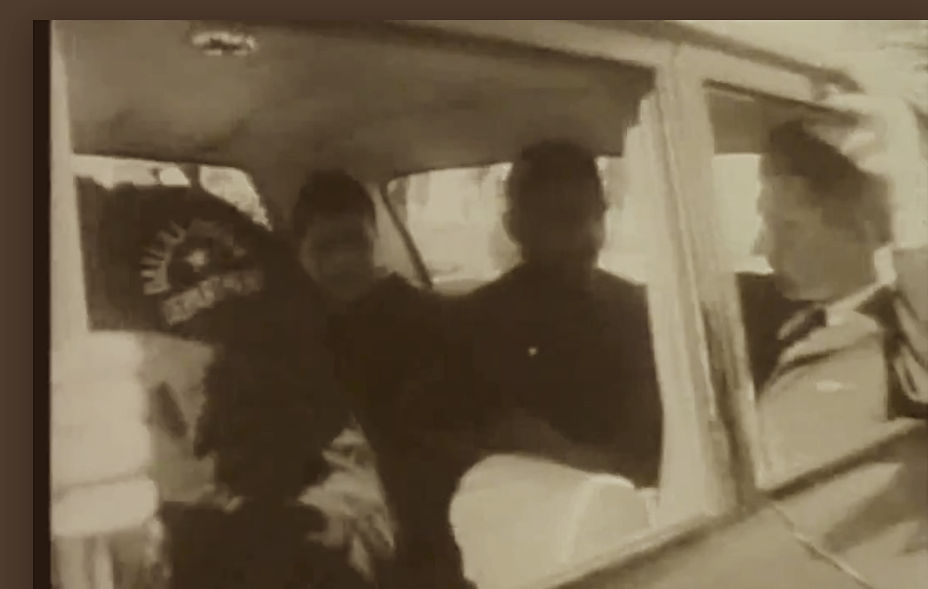
- Danny Arce, Bonnie Ray Williams, Bill Shelley
Bonnie Ray Williams told the Warren Commission:
Mr. WILLIAMS. ...First I think they took me and another
fellow, Danny--
they took us in one car. Then they took some other fellows in another
car, and then another car, I think.
Mr. BALL. You were with Danny Arce and one or two police officers?
Mr. WILLIAMS. Yes, sir.
Mr. BALL. Anybody else?
Mr. WILLIAMS. That's all....They brought Bill Shelley and Bill
Lovelady, a fellow by the name of Jack Dougherty, and Charles Givens
later on, they brought them right behind us.
In Shelley's 11/22/63 affidavit he wrote, "I went back to the building
& went inside & called my wife & told her what happened. I
was on the first floor then & I stayed at the elevator & was
told not to let anyone out of the elevator. I left the elevator and
went with the police on up to the other floors." (see affidavit
below, left). In Lovelady's 11/22/63 affidavit he wrote, "After it was
over we went back into the building and went to work took
some police officers up to search the building"
(see affidavit below, right). Moments after the last shot was fired at
President Kennedy, Shelley and Lovelady were at the back of the TSBD on
the 1st floor, and both men then accompanied police officers as
they searched the building.
Moments after arriving at the back of the TSBD both of these men were
seen by Victoria Adams, who told Shelley that shots had been fired at
President Kennedy. Adams told WC attorney David Belin that after shots
were fired, she ran down the wooden stairs at the back of the building.
Her supervisor, Dorothy Garner,
followed Adams and Sandra Styles from their office to the stairs and
watched the two women as they ran down the stairs. One minute later
they arrived on the first floor where Adams saw the two men, Bill
Shelley and Billy Lovelady, and ran outside onto the loading dock.
Moments later Roy Truly and Officer Baker arrived at the back of the
TSBD on the first floor and saw two "white men." Truly did not identify
these men to Officer Baker as strangers, which is a good indication
that he knew both men--the same two men seen by Victoria Adams and
Sandra Styles only moments earlier--Bill Shelley, who worked directly
under Truly and TSBD employee Billy Lovelady. Truly knew the
electricity had been turned off because the elevators were not working.
He knew the location of the nearby electrical panels, and he knew one
of his employees was standing near these panels. If Truly was not a
co-conspirator then he should have been suspicious of Shelley and
Lovelady, and asked what they were doing at the back of the TSBD less
than a minute after the shooting. But Truly said nothing. After
noticing the elevators were not working, Truly should have checked the
circuit for the elevators and lights in the electrical panel, but Truly
did nothing. Instead, Truly ignored his two employees, ignored the
electrical panels, and began to run up the stairs, ahead of Officer
Baker. We must wonder why an unarmed
civilian (Truly) would run up the stairs, ahead of an armed police
officer, to search for a man who just shot and killed (allegedly) the
President of the United States. His behaviour, showing no fear or
concern for his safety, is very suspicious and raises even more doubt
and skepticism about his true roll in the events of 11/22/63. Truly's
indifference at the back of the building, about 1 1/2 minutes after the
shooting, raises doubts, questions, and skepticism as to his behaviour,
his motive, and his possible collusion with Shelley and Lovelady.
As Officer Baker and Truly began running up the darkened
stairway,
supervisor Dorothy Garner was still standing next to the stairs on the
4th floor, after watching her employees Victoria Adams and Sandra
Styles hurry down the stairs. As Baker and Truly ran up the stairs the
two men on the first floor turned the electricity back on.
QUESTION: Was the electricity turned on when
Officer Baker saw and confronted Oswald in the lunchroom, and described
the clothing he was wearing? The lunchroom had no windows, and without
ceiling lights would have been very dark.
After the electricity was turned on the two men from the 6th floor (white
shirt; brown jacket) were able to ride the elevator from the 4th
floor to the 2nd floor where one of the men (LEE Oswald--white shirt)
got off the elevator. LEE Oswald (white shirt),
anxious to avoid crowds on the 1st floor, likely walked thru the
hallway on the 2nd floor toward the old wooden stairway at the back of
the building (follow the RED
line below). His His intention was to walk down the steps to the
first floor, and then leave out the west side of the building under the
watchful eye of supervisor Bill Shelley. However, as LEE Oswald
approached the hallway door leading to the stairs and lunchroom he may
have heard people running up or down the stairs (Baker and
Truly). He hesitated and then, without opening the door directly
in front of him (see position 27 below), opened the door immediately to
his right and walked into the TSBD office (follow
the GREEN line). LEE Oswald continued to walk thru the TSBD
office, which was unfamiliar to him and unfamiliar to most warehouse
workers. LEE Oswald, wearing a white shirt and carrying a Coke, was
last seen by Mrs. Reid when he walked out the front door of the office
and into the hallway.
Mrs. Reid, a TSBD employee, had just returned to her office when Oswald
(LEE) walked into the office from the back door. As he walked thru the
office Mrs. Reid said that he was wearing a white t-shirt and
carrying a bottle of Coke. Mrs. Reid's testimony caused a great deal of
trouble for the Warren Commission. The Commission knew that Oswald
(HARVEY), when confronted by Officer Baker in the lunchroom, was
wearing a long-sleeve brown shirt. The Commission, however,
tried in vain to explain that a minute or two later Oswald (HARVEY)
walked thru Mrs. Reid's office wearing a white shirt. But the
Commission never understood nor was able to explain how Oswald (HARVEY)
could wear a brown shirt in the lunch room, then only seconds
later wear a white t-shirt in Mrs. Reid's office, then wear a brown
shirt on Cecil McWatter's city bus, wear a brown shirt in
William Whaley's taxi, and wear a brown shirt in the Texas
Theater. The Warren Commission never resolved this "white
shirt/brown shirt" conflict, because they never understood nor
realized there were two "Lee Harvey Oswalds" in the TSBD on 11/22/63.
The man wearing the white t-shirt was on the 6th floor for the
purpose of setting up HARVEY Oswald as the "patsy" (who was in the 1st
floor domino room/lunchroom).
LEE OSWALD. After the shots were fired LEE Oswald rode the
passenger elevator from the 6th to the 2nd floor, walked thru the TSBD
office wearing a white t-shirt, left the building wearing a white
t-shirt, and got into a Nash Rambler station wagon wearing a white
t-shirt.
HARVEY OSWALD, wearing a long sleeve brown shirt in
the lunchroom, where he was confronted by Officer Baker, walked to the
main entrance of the TSBD wearing a long sleeve brown shirt,
left the building wearing a long sleeve brown shirt, was
wearing a brown shirt on Cecil McWatter's city bus, was
wearing a brown shirt William Whaley's taxi, and wearing a brown
shirt when arrested at the Texas Theater .
THE DETAILS: WHITE SHIRT/BROWN SHIRT is easy to
explain and
understand. LEE Oswald was wearing the white t-shirt on the 6th
floor (12:30 PM), wearing the white t-shirt when he walked thru
Mrs. Reid's office (12:34 PM), wearing the white t-shirt when
he got into the Nash Rambler (12:40 PM), wearing the white t-shirt
when he shot Officer Tippit (1:06 PM), wearing the white t-shirt when
he was in the balcony at the Texas Theater (1:40 PM), and wearing the white
t-shirt
when he was seen sitting in a red Ford Falcon at the El Chico
restaurant parking lot (2:15 PM). HARVEY Oswald was wearing the
long-sleeve brown shirt when confronted by Baker and Truly
(12:32 PM), wearing the long-sleeve brown shirt on Cecil
McWatters' city bus (12:40 PM), wearing the long-sleeve brown shirt
in William Whaley's taxi (12:50 PM), wearing the long-sleeve brown
shirt when arrested in the Texas Theater (1:52 PM), and wearing the
long-sleeve brown shirt when
taken to police headquarters (2:00 PM). It may be very difficult for
some people to follow the activities of Harvey and Lee on November 22.
But if you just remember "white shirt (LEE Oswald)--brown shirt
(HARVEY Oswald)" it is much
easier.
After (LEE) Oswald left the elevator on the 2nd floor, the man from the
6th floor wearing a brown jacket likely rode the passenger
elevator to the 1st floor. He got off the elevator, hurried to the rear
of the building, and likely passed by Shelley and Lovelady as he left
the building. This man, wearing a brown jacket, was seen by
James Worrell as he hurried out the back of the TSBD and then began
walking south on Houston St. One block south this man walked past
Richard Carr, who had seen this man a few minutes earlier on the 6th
floor. Carr noticed this man was continually looking back over his
shoulder as he was walking, and saw this man get into a Nash Rambler
station wagon facing north on Record Street. Deputy Sheriff Roger Craig
saw the same man, driving the Nash Rambler station wagon a few minutes
later, when the station wagon stopped in front of the grassy knoll and
picked up LEE Oswald, wearing a light colored shirt.
Bill Shelley and Billy Lovelady on the first
floor
On the afternoon of 11/22/63 both Shelley and Lovelady said they
returned to the building after the shooting (see affidavit's above).
The presence of Shelley and Lovelady at the rear of the building, only
a minute after the shooting, has never been explained, investigated,
nor understood, yet was a major concern to the Warren Commission for
several reasons....
1) The first and most important reason was "What were they doing at the
back of the TSBD, only one minute after the shooting?" Seconds after
the shooting Victoria Adams and Sandra Styles left their office on the
4th floor and began running down the old wooden stairs. Neither Adams
nor Styles saw nor heard anyone else running down the stairway. Adams
arrived on the 1st floor in one minute, saw and spoke to Shelley and
Lovelady, and then hurried out the back door and onto the loading dock.
The Warren Commission had to explain and show how Oswald was able to
get from the 6th floor to the 2nd floor lunchroom, where confronted by
Baker, while at the same time Adams and Styles were running down the
stairs and Dorothy Garner was standing next to the stairs on the 4th
floor.
NOTE: The biggest problem, however, was not
Victoria Adams, it was her supervisor--Dorothy Garner. After the last
shot was fired Garner followed the two young ladies to the nearby
stairway, stood at the 4th floor stairway, and watched the two young
women run down the stairs. Moments later Garner saw officer Baker and
Roy Truly arrive on the 4th floor and continue running to the 5th
floor. Nobody, including Oswald, came down these stairs after the
shooting.
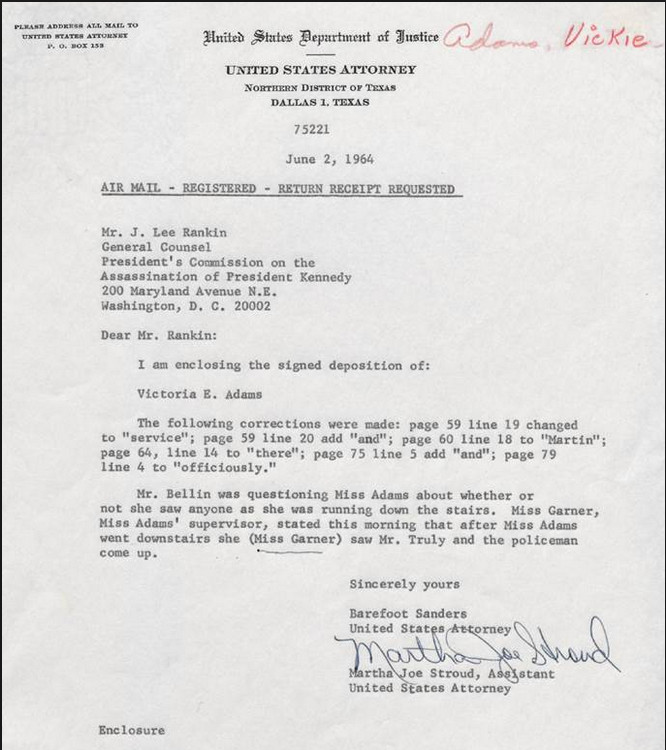
2)
The second problem for the FBI/WC to resolve was the possibility that
Bill Shelley and Billy Lovelady, seen on the 1st floor by Victoria
Adams, were co-conspirators, and were waiting for the two men from the
6th floor to arrive on the 1st floor and leave out the back of the TSBD.
LEE Oswald, the young man wearing the white shirt on the 6th floor, got
off the passenger elevator on the 2nd floor and was supposed to walk
down the rear stairs to the 1st floor and then, accompanied by Bill
Shelley, hurry out the back of
the TSBD (instead, however, he walked thru the TSBD office on the 2nd
floor where he was seen by Mrs. Reid). The man on the 6th floor,
wearing the brown coat, got off the passenger elevator on the 1st floor
and left the TSBD thru a rear door. This man was seen by Richard
Worrell, hurrying out the back of the TSBD, and then walking south on
Houston St. where this same man was seen by Richard Carr.
NOTE: I believe Shelley and Lovelady WERE
waiting for LEE Oswald to arrive on the 1st floor via the stairway, but
LEE Oswald had instead left the TSBD thru an overhead door on the west
side of the building. HARVEY Oswald, after his encounter with Baker and
Truly, hurried to the 1st floor and looked out the glass entry door
while attempting to locate his contact/supervisor, Bill Shelley. HARVEY
Oswald then hurried to the rear of the TSBD where he located and
briefly talked with Shelley. He then picked up his jacket from the
Domino Room, left the TSBD and onto the loading dock, and then began
walking south on Houston St. (seen by Wesley Frazier)
3) The third problem, never considered, never explained, and never
investigated was the fact that the electricity in the TSBD had been
turned off a couple of minutes before the motorcade passed in front of
the TSBD, and then turned back on 1-2 minutes after shots were fired at
the President. Lovelady told the WC that he was by the Domino Room
(near the electrical panels) moments before the Presidents' motorcade
drove by the TSBD. Less than an hour after the shooting, both
Shelley and Lovelady told the DPD that after the shooting they went
back inside the TSBD and were at the back of the building (near the
electrical panels). The significance of the electricity being turned
off (all or partially) only moments before the assassination and turned
back on moments after the shooting was not a coincidence and should
never have been ignored. A simple check for fingerprints on the cover
of the electrical panels and fingerprints on one or more of the
switches inside the panels may have identified the person(s)
responsible for the electrical shut off/on. If Shelley/Lovelady
were not responsible for interruption of the electrical service during
the Presidential parade, then who was?
Images of Bill Shelley (5'6" tall; thin
build; red hair
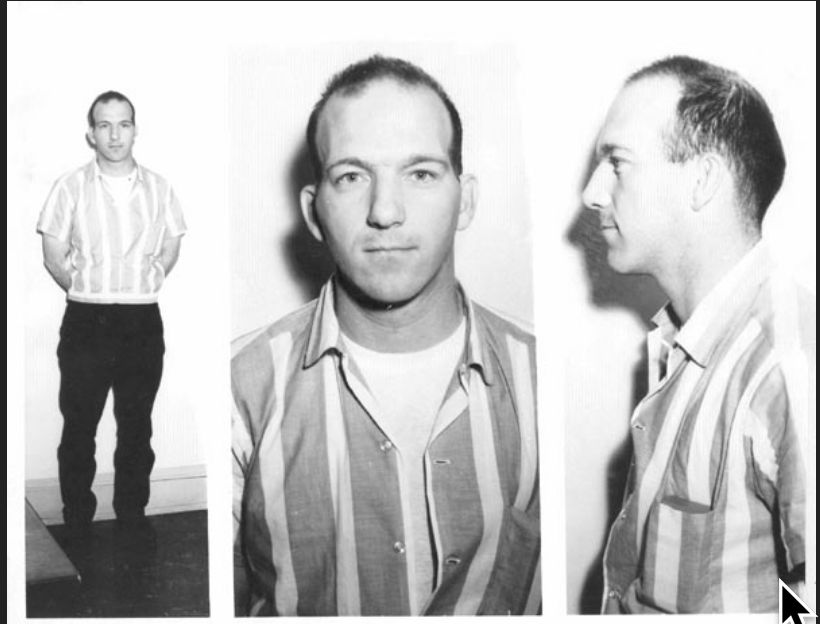 |

|
Images of
Billy Lovelady (5'8" tall; medium build; thin brown hair)
|
Bill
Shelley and Billy Lovelady's presence at the rear of the building on
the first floor, only moments after the shooting, was a serious
problem. With Adams and Styles running from the 4th floor to the first
floor, followed moments later by Officer Baker and Roy Truly running
from the 1st floor to the 5th floor, it was impossible for anyone to
have ran down those old, creaky wooden stairs at the same time without
being seen or heard by Adams, Styles, or their supervisor Dorothy
Garner. Somehow this problem had to be "resolved" in order for the
Warren Commission to show that "Oswald," after firing shots at
President Kennedy, left the 6th floor, ran down the stairs to the 2nd
floor lunchroom, was confronted by Officer Baker, and soon walked out
the front of the TSBD. The way to "resolve" this problem was to
ignore Dorothy Garner, and attack and challenge Adams' claim that she
was on the 1st floor one minute after the shooting. And Bill Shelley
and Billy Lovelady either had to "disappear" from the first floor, or
change their stories and claim they arrived on the first floor much
later where they were seen by Victoria Adams.
Identifying and "resolving" the problem
Victoria Adams was interviewed by the FBI on 11/24/63. The report read,
"She and her friend (Sandra Styles) ran immediately to the back of the
building to where the stairs were located and ran down the stairs. No
one else was observed on the stairs at this time, and Adams was sure
that
this would be the only means of escape from the building from the sixth
floor." Adams said, "Whenever anyone was on the stairs you could
hear them on any floor. We would have heard someone on the stairs.
Absolutely." Adams and Styles ran out of the building, turned to the
left and ran across the railroad tracks...." The
FBI altered statements of many witnesses, and so we don't know with
certainty what Victoria Adams really told the FBI agents on 11/24/63,
but this FBI report does not mention anything about Shelley or Lovelady.
JFK researcher Barry Ernest, author of The Girl on the Stairs,
interviewed Victoria Adams in 2002, nearly 40 years after the
assassination. He wrote, "The initial statements
Ms. Adams made to investigators in her office that Friday afternoon
(11/22/63) hoisted some flags. Ms. Adams suddenly became a focus of
attention, questioned repeatedly by various agencies, always about the
same thing: her trip down the stairs and exactly when she made it.
Adams said, "It really didn't dawn on me that my actions were pertinent
to anything until much later. In Dallas, the people in my office were
pretty chagrined that the secret police and the CIA and all those
others were interested in me. And, quite frankly, I couldn't figure out
why they were so interested. At least then."
NOTE: Adams
ran down the stairs (from the 4th floor), arrived on the 1st floor
within one minute of the shooting, and heard nobody running up or down
the stairway. Oswald (HARVEY) could not possibly have run from the
sniper's nest to the NW stairway, and down 4 flights of stairs to the
2nd floor lunchroom, before Adams and Styles began running down the
stairs from the 4th floor. It is now very clear that Oswald (HARVEY)
was already in
the lunchroom when Adams and Styles ran down the stairs and arrived on
the first floor within one minute of the shooting. Moments later, as
Dorothy Garner stood next to the stairs on the 4th floor, Officer Baker
and Roy Truly confronted Oswald in the 2nd floor lunchroom. They then
ran up to the 4th floor, where they were seen by Dorothy Garner, and
continued running up to the 5th floor. Victoria Adams became a target
because her statement, if true, proved that Oswald (HARVEY) could not
possibly have been on the 6th floor at the time of the shooting.
Unknown to Adams at the time, she had become a target. She was watched,
followed, and interviewed by government investigators continuously
during the weeks and months following the assassination. Whenever these
people appeared they always asked her exactly when she began
her trip down the stairs. When she left her office for lunch or at the
end of the day she saw some of these same men watching her as she
walked from the building. On one occasion she stopped one of them--an
FBI agent who had been in her office that morning, and was now
following her thru town. She told these investigators again and again
the same story about leaving her office and running down the stairs.
Adams was very young (23 years old), alone, without family in a big
city, and was becoming more and more frightened.
She recalled one such troubling encounter and told JFK
investigator/author Barry Ernest, "One time [at 8:00 PM, February 17,
1964], a
detective from the Dallas police (James Leavelle) came to my apartment,
showed his badge, and asked to talk with me. I asked him why he needed
to talk with me since I had already given my testimony to the Dallas
Police. 'Oh,' he responded, 'the records were all burned in a fire we
had and we have to interview everyone again. So I once again said the
same thing, which at that point felt like ad nauseum." The
officer's sudden appearance that evening was strange too because Ms.
Adams had only the day before moved to this location, a new apartment.
She had not yet notified anyone--not her boss, associates in her
office, or even the post office--of her change of address. The
apartment was even rented in her roommate's name. Ms. Adams became
nervous about how the police had found her and, in hindsight, figures
she must somehow have been followed (The Girl on the Stairs).
In July, Adams was offered a job with Scott Foresman's home office in
Chicago, which she gratefully accepted.
On February 17, 1964 Victoria Adams told DPD detective James Leavelle
that she had seen "Mr. Shelley and another employee named Bill" on the
first floor.
Bill Shelley and Billy Lovelady--2nd version
On March 19, 1964,
Bill Shelley was interviewed by the FBI, but changed his story. Four
months earlier, on 11/22/63, Shelley told the Dallas Police, "I went
back to the building & went inside & called my wife & told
her what happened. I was on the first floor then & I stayed
at the elevator & was told not to let anyone out of the elevator."
Four months later, on March 18, 1964, Shelley changed his story and
told the FBI, "Immediately following
the shooting, Billy N. Lovelady and I accompanied some uniformed police
officers to the railroad yards just west of the building and returned
through the west side door of the building about ten minutes later"
(see CE 1381, below). By claiming that he and Lovelady re-entered the
TSBD ten minutes later, Shelley was now (4 months later) challenging
Victoria Adams' testimony that she saw and spoke to Shelley on the 1st
floor only one minute after the shooting. By claiming that he and
Lovelady returned to the TSBD ten minutes after the shooting, and were
then seen by Victoria Adams, there was now enough time for (HARVEY)
Oswald to
have run from the 6th floor sniper's nest to the 2nd floor lunchroom
where he was
confronted by Officer Baker.
On March 19, 1964,
the same day the FBI re-interviewed Shelley, Billy Lovelady was
interviewed by the FBI, and he too changed his story. Four months
earlier, on 11/22/63, Lovelady told the Dallas Police, "After it was
over we went back into the building and went to work
took
some police officers up to search the building." Four months
later, on March 19, 1964, Lovelady told the FBI, "I recall that
following the shooting, I
ran toward the spot where President Kennedy's car stopped. William
Shelley and myself stayed in that area for approximately five
minutes when we then re-entered the Depository building
by the side door located on the west side of the building" (see CE
1381, below). By claiming that he and Shelley ran to where President
Kennedy's car stopped, and re-entered the TSBD five minutes later,
Lovelady was also (4 months later) challenging Victoria Adams'
testimony that she saw Lovelady on the 1st floor only one minute after
the shooting. By claiming that he and Shelley returned to the TSBD 5
minutes after the shooting, when they were seen by Victoria Adams,
there was now enough time for (HARVEY) Oswald to have run from the 6th
floor
to the 2nd floor lunchroom, where he was confronted by Officer Baker.
On March 23, 1964
the FBI again interviewed Victoria Adams who said, "After the third
shot I observed the car carrying President Kennedy speed away. Sandra
Styles and I then ran out of the building via the stairs and went in
the direction of the railroad where we had observed other people
running." We don't know with certainty what Victoria Adams really
told the FBI agents on 3/23/64, but this FBI report does not mention
anything about Adams descending the stairs to the first floor, at the
rear of the TSBD, and then observing and talking to Shelley or Lovelady.
On March 25, 1964, Officer Marrion Baker told the Warren
Commission that when he and Roy Truly arrived on the first floor at the
back of the TSBD, only moments after the shooting, he saw two unknown
men. One of these men was standing near the stairs (with the
electricity shut off, the only access to the 6th floor) and the other
man about 20-30 feet away (near the electrical panels). WC member Allen
Dulles asked, "Were they white men?" Baker replied, "Yes." These
two men were undoubtedly the same two men seen by Victoria Adams and
Sandra Styles only moments before Baker and Truly arrived.
NOTE: It is important to remember that Baker
told the WC about the two unknown men on the first floor TWO WEEKS
BEFORE Victoria
Adams told the WC that she saw Bill Shelley and Billy Lovelady
when she arrived on the first floor one minute after the shooting--only
moments before Baker and Truly arrived on the first floor.
In March, 1964,
four months after Shelley and Lovelady said they returned to the TSBD
after the shooting, they were now claiming they did not return to the
TSBD for between 5 and 10 minutes. Lovelady later told the HSCA
that he did not return to the building for 25 minutes.
NOTE: In January 1979, near the end of the HSCA
hearings, Billy Lovelady died of a heart attack at age 41. His
wife, Patricia, refused to discuss his death except to say, “I have
been harassed for 15 years, and I'm not going to be harassed any more."
Warren Commission attorney David Belin was familiar with Shelley and
Lovelady's statements, wherein they said they did not return to the
TSBD for 5 to 10 minutes. Belin was likely familiar with Victoria
Adams' 2/17/64 statement to Jim Levelle, wherein she said that after
running from the 4th floor to the 1st floor, she saw Shelley and
Lovelady only one minute after the shooting. Belin knew that Adams'
statement, if true and unchallenged, would make it virtually impossible
for the Warren Commission to prove that "Oswald" ran from the sniper's
nest on the 6th floor to the 2nd floor lunchroom after shooting
President Kennedy. Her unaltered testimony would also allow
critics to suggest that Shelley and Lovelady were conspirators, waiting
for the shooters to arrive on the 1st floor only one minute after the
shooting. Before questioning Adams under oath, attorney Belin said to
her, "Now Miss Adams, don't you think you could be wrong? Memory is a
funny thing and tricks some people." Adams recalled, "I looked him
straight in the eye and said, 'I could be, but I'm not wrong. I know
what I saw, what I did and what I heard.'"
Victoria Adams testimony before the Warren
Commission--April 7, 1964 (2:15 PM)
Victoria Adams testified before the Warren Commission and provided very
detailed answers to questions asked by attorney David Belin.
Mr. BELIN - Were you standing with anyone?
Miss ADAMS - I was standing with Sandra Styles, Elsie Dorman, and
Dorothy May Garner.
Miss ADAMS - ... and we heard a shot, and it was a pause, and then a
second shot, and then a third shot.... And after the third shot,
following that, the third shot, I went to the back of the building down
the back stairs, and encountered Bill Shelley and Bill Lovelady on the
first floor on the way out to the Houston Street dock.
Mr. BELIN - When you say on the way out to the Houston Street dock, you
mean now you were on the way out?
Miss ADAMS - While I was on the way out.
Mr. BELIN - Was anyone going along with you?
Miss ADAMS - Yes, sir; Sandra Styles.
Mr. BELIN - As you ran down the stairs, did you see anyone on the
stairs?
Miss ADAMS - No, sir.
Mr. BELIN - When you got to the bottom of the first floor, did you see
anyone there as you entered the first floor from the stairway?
Miss ADAMS - Yes, sir.
Mr. BELIN - Who did you see?
Miss ADAMS - Mr. Bill Shelley and Billy Lovelady.
Mr. BELIN - Where did you see them on the first floor?
Miss ADAMS - Well, this is the stairs, and this is the Houston Street
dock that I went out. They were approximately in this position here, so
I don't know how you would describe that.
Mr. BELIN - You are looking now at a first floor plan or diagram of the
Texas School Book Depository, and you have pointed to a position where
you encountered Bill Lovelady and Mr. Bill Shelley?
Miss ADAMS - That's correct.
Mr. BELIN - It would be slightly east of the front of the east
elevator, and probably as far south as the length of the elevator, is
that correct?
Miss ADAMS - Yes, sir.
Mr. BELIN - I have a document here called Commission's Exhibit No. 496,
which includes a diagram of the first floor, and there is a No. 7 and a
circle on it, and I have pointed to a place marked No. 7 on the
diagram. Is that correct?
Miss ADAMS - That is approximate.
NOTE: Commission Exhibit 496, published in
the W.C. volumes, is not the diagram given to Adams. CE 496 is a
copy of an application form Oswald filled out for his job at the TSBD.
The document upon which Victoria Adams indicated the spot where she saw
Shelley and Lovelady disappeared.
Mr. BELIN - Now when you were running down the stairs on your trip down
the stairs, did you hear anyone using the Stairs?
Miss ADAMS - No, sir.
Mr. BELIN - Did you hear anyone calling for an elevator?
Miss ADAMS - No, sir.
Mr. BELIN - Did you see the foreman, Roy Truly? Did you see the
superintendent of the warehouse, Roy S. Truly?
Miss ADAMS - No, sir; I did not.
Mr. BELIN - What about any motorcycle police officers?
Miss ADAMS - No, sir.
Mr. BELIN - Now what did you do after you encountered Mr. Shelley and
Mr. Lovelady?
Miss ADAMS - I said I believed the President was shot.
Mr. BELIN - Do you remember what they said?
Miss ADAMS - Nothing.
Mr. BELIN - Then what did you do?
Miss ADAMS - I proceeded out to the Houston Street dock.
Mr. BELIN - How long do you think it was between the time the shots
were fired and the time you left the window to start toward the
stairway?
Miss ADAMS - Between 15 and 30 seconds, estimated, approximately.
Mr. BELIN - How long do you think it was, or do you think it took you
to get from the window to the top of the fourth floor stairs?
Miss ADAMS - I don't think I can answer that question accurately,
because the time approximation, without a stopwatch, would be difficult.
Mr. BELIN - How long do you think it took you to get from the window to
the bottom of the stairs on the first floor?
Miss ADAMS - I would say no longer than a minute at the most.
Mr. BELIN - So you think that from the time you left the window on the
fourth floor until the time you got to the stairs at the bottom of the
first floor, was approximately 1 minute?
Miss ADAMS - Yes, approximately.
Mr. BELIN - As I understand your testimony previously, you saw neither
Roy Truly nor any motorcycle police officer at any time?
Miss ADAMS - That's correct.
Mr. BELIN - You heard no one else running down the stairs?
Miss ADAMS - Correct.
Mr. BELIN - When you got to the first floor did you immediately proceed
to this point where you say you encountered Mr. Shelley and Mr.
Lovelady? Well, you showed me on a diagram of the first floor that
there was a place which was south and somewhat east of the front part
of the east elevator that you encountered Truly and Lovelady?
Miss ADAMS - I saw them there.
Mr. BELIN - I mean; you saw them?
Miss ADAMS - Yes.
Mr. BELIN - Would that have been a matter of seconds after you got to
the bottom of the first floor?
Miss ADAMS - Definitely.
Mr. BELIN - Less than 30 seconds?
Miss ADAMS - Yes.
Mr. BELIN - During the trip down the stairs on the way down did you
ever encounter Lee Harvey Oswald?
Miss ADAMS - No, sir.
The Warren Commission concluded that if Victoria Adams was
correct with her timing, she "would probably have seen or
heard...Oswald either above or below her." Sandra Styles and supervisor
Dorothy Garner would have corroborated her story as to the time that
she and Styles ran down the stairs--only moments after the shooting.
But these two women were never questioned by the Warren
Commission,
because their combined testimony would have been nearly impossible
for the Warren Commission to challenge.
A few days after her testimony, a man showed up at the Scott, Foresman
office at the TSBD and asked to speak with Ms. Adams. He handed Adams a
transcript of her W.C. deposition and asked her to read the document,
make corrections, and then sign the document. Adams read the transcript
carefully, made changes to grammar and content, signed the document,
and gave it back to the man who then left the office. The Warren
Commission classified Adams' corrected and signed deposition as "TOP
SECRET," because they knew that critics would claim this document
was proof that Oswald could not possibly have ran from the sniper's
nest down to the 1st floor while at the same time Adams and Styles were
running down the stairs.
Billy Lovelady's testimony before the Warren
Commission--April 7, 1964 (3:50 PM)--3rd version of events
After Victoria Adams was questioned by David Belin, WC attorney Joseph
Ball interviewed Billy Lovelady, who now changed his testimony
for the
3rd time:
- #1 -- affidavit--"we went back into the building and took
some police officers up to search the building."
- #2 -- FBI interview--"following the shooting I ran toward the
spot where President Kennedy's car had stopped. William Shelley and
myself stayed in that area for approximately five minutes when we then
re-entered the Depository building by the side door."
- #3 -- WC testimony....
Mr. BALL - When Gloria came up and said the President had
been shot, Gloria Calvary, what did you do?
Mr. LOVELADY - ... we run towards that little, old island and kind of
down there in that little street. We went as far as the first tracks
and everybody was hollering and crying and policemen started running
out that way and we said we better get back into the building, so we
went back into the west entrance on the back dock had that low ramp and
went into the back dock back inside the building.
Mr. BALL - By the time you left the steps had Mr. Truly entered the
building?
Mr. LOVELADY - As we left the steps I would say we were at least 15,
maybe 25, steps away from the building. I looked back and I saw him and
the policeman running into the building.
By claiming he saw Truly and a policeman enter the
TSBD, Lovelady was attempting to provide proof that he was outside of
the TSBD
one minute after the shooting, and not at the rear of the TSBD on the
first floor where he was
seen by Victoria Adams and likely one of the two "white men" seen by
Officer Baker 1 1/2 minutes after the shooting.
Mr. BALL - After you ran to the railroad tracks you came
back and went in the back door of the building?
Mr. LOVELADY - Right.
Mr. BALL - Who did you see in the first floor?
Mr. LOVELADY - I saw a girl but I wouldn't swear to it it's Vickie.
QUESTION:
How would Lovelady know the girl's name was"Vickie" when her name
hadn't been previously mentioned during his testimony or questioning? Because
Lovelady knew that Vickie Adams saw him on the first floor one minute
after the shooting.
Mr. BALL - Who is Vickie?
Mr. LOVELADY - The girl that works for Scott, Foresman.
Lovelady can't swear that it was Vickie, yet he
knows that Vickie worked for Scott, Foresman.
Mr. BALL - What is her full name?
Mr. LOVELADY - I wouldn't know.
Mr. BALL - Vickie Adams?
The only way that WC attorney Ball knew Vickie
Adams' name was from her WC testimony, taken a few hours earlier,
wherein she said that she saw Shelley and Lovelady on the 1st floor one
minute after the shooting. The fact that Ball questioned Lovelady about
who he saw on the 1st floor, and then asked Lovelady if her full name
was 'Vickie Adams,' is confirmation that Adams told the W.C. about
Shelley and Lovelady when she arrived on the first floor. If Adams had
not mentioned Shelley and Lovelady in her W.C. testimony, then how
would Ball know to ask Lovelady if he saw Vickie Adams on the 1st floor?
Mr. LOVELADY - I believe so.
Mr. BALL - Would you say it was Vickie you saw?
Mr. LOVELADY - I couldn't swear.
Mr. BALL - Where was the girl?
Mr. LOVELADY - I don't remember what place she was but I remember
seeing a girl as she was talking to Bill or saw Bill or something....
The
WC ignored the DPD interview of Adams, ignored Adams' signed
deposition, ignored her WC testimony, and never interviewed Sandra
Styles or supervisor Dorothy Garner. The WC instead chose to accept and
then relied upon the testimony of Billy Lovelady in order to solve the
"timing problem." After the shooting Lovelady claimed to have walked to
the railroad tracks, walked around the west side of the building, and
then re-entered the TSBD 5 or 10 minutes later where he saw a girl on
the first floor talking to Bill (Shelley). The W.C. was then able to
conclude that Victoria Adams could not have seen Shelley or Lovelady on
the first floor only one minute after the shooting, because both men
were outside of the TSBD at that time. The commission decided that
Adams arrived on the 1st floor ten minutes after the shooting, and only
then saw Shelley and Lovelady. Now there was enough time for Oswald to
have hurried from the sniper's window, run down the stairway, enter the
lunchroom, and be confronted by Officer Baker.
William Shelley's testimony before the Warren
Commission--April 7, 1964 (4:10 PM)
Minutes
after Lovelady's testimony ended WC attorney Joseph Ball interviewed
Bill Shelley, who now changed his testimony for the 3rd time:
- #1 -- DPD affidavit--"I ran across the street to the corner
of the park (about 45 ft). I ran into a girl crying and she said the
President had been shot. I went back to the building and went inside
and called my wife and told her what happened. I was on the first floor
then and I stayed at the elevator....."
- #2 -- FBI interview--"Immediately following the shooting,
Billy N. Lovelady and I accompanied some uniformed police officers to
the railroad yards just west of the building and returned through the
west side door of the building about ten minutes later."
- #3 -- WC testimony.....
Mr. SHELLEY - Gloria Calvary from South-Western
Publishing Co. ran back up there crying and said "The President has
been shot" and Billy Lovelady and myself took off across the street to
that little, old island and we stopped there for a minute.
NOTE: Gloria Calvary was not interviewed by
the Warren Commission.
Mr. BALL - You went out there and then what did you do?
Mr. SHELLEY - Well, officers started running down to the railroad yards
and Billy and I walked down that way.
NOTE: On 11/22/63 Shelley gave an affidavit
to the Dallas Police and, less than one hour after the assassination,
said, "I went back to the building and went inside and called my wife
and told her what happened. I was on the first floor then and I stayed
at the elevator...."
Mr. BALL - Did you see Truly, Mr. Truly and an officer go into the
building?
Mr. SHELLEY - Yeah, we saw them right at the front of the building
while we were on the island.
Mr. BALL - Do you have any idea how long it was from the time you heard
those three sounds or three noises until you saw Truly and Baker going
into the building?
Mr. SHELLEY - It would have to be 3 or 4 minutes I would say because
this girl that ran back up there was down near where the car was when
the President was hit.
By claiming he saw Truly and a policeman enter the
TSBD 3 or 4
minutes after the shooting, Shelley is attempting to provide proof that
Victoria Adams could not have seen and spoken to him one minute after
the shooting, and that he was not one of the two white men seen by
Officer Baker on the 1st floor 1 1/2 minutes after the shooting.
Mr. BALL - What did you and Billy Lovelady do?
Mr. SHELLEY - We walked on down to the first railroad track there on
the dead-end street and stood there and watched them searching cars
down there in the parking lots for a little while and then we came in
through our parking lot at the west end.
Mr. BALL - At the west end?
Mr. SHELLEY - Yes; and then in the side door into the shipping room.
Mr. BALL - Of the first floor of the building?
Mr. SHELLEY - Yes.
Mr. BALL - Did you ever see Vickie Adams?
The only way that Ball knew Vickie Adams' name was
from her WC testimony, taken a few hours earlier, wherein she said that
she saw Shelley and Lovelady on the 1st floor one minute after the
shooting. The fact that Ball asked Shelley if he saw 'Vickie Adams' on
the first floor is confirmation that Adams, only a few hours earlier
that same day, told the W.C. that she saw and spoke to Shelley when she
arrived on the first floor. If Adams had not mentioned Shelley in
her W.C. testimony, then how would Ball know to ask Shelley if he saw
Vickie Adams on the 1st floor?
Mr. SHELLEY - I saw her that day but I don't remember where I saw her.
Mr. BALL - You don't remember whether you saw her when you came back?
Mr. SHELLEY - It was after we entered the building.
Mr. BALL - You think you did see her after you entered the building?
Mr. SHELLEY - Yes, sir; I thought it was on the fourth floor awhile
after that.
Shelley, like Lovelady, is now claiming that he
"may" have seen Victoria Adams but can't remember where or when he saw
her.
Mr. BALL - Did you see Vickie Adams after you came into
the building and did you see her on the first floor?
Mr. SHELLEY - I sure don't remember.
Mr. BALL - You don't.
Mr. SHELLEY - No.
At
the end of the day (April 7, 1964) the WC had a DPD police report and
Adams' testimony that she saw Shelley and Lovelady on the 1st floor one
minute after the shooting. They also had Shelley and
Lovelady's DPD affidavits wherein both men said that immediately after
the shooting they went back into the building. The commission also had
FBI reports and now had their WC testimony that contradicted both
Adams' testimony and Shelley/Lovelady's affidavits of 11/22/63. Why the
WC did not ask Shelley or Lovelady to explain why their DPD affidavits
conflicted with their testimony is now obvious, The WC knew that Oswald
could not have ran down the stairs within one minute of the shooting,
because he would have been seen or heard by Adams and Styles. The
commission's only option was to accept, without question, the testimony
of Shelley and Lovlady who said they did not return to the TSBD for 10
minutes.
The Commission accepted and relied upon their W.C. testimony, wherein
Shelley/Lovelady said they did not return to the TSBD for 5-10 minutes.
They concluded that Lovelady may have seen Adams talking with Shelley,
and that Shelley may have seen Adams later in the day on the 4th floor.
The Commission found there was now enough time for Oswald (HARVEY) to
have run from the 6th floor to the 2nd floor lunchroom AFTER Adams and
Styles ran down the stairs and left the TSBD
On May 14, 1964, 5 weeks after
learning from Victoria Adams and Officer Marrion Baker about the two
men
on the 1st floor between one and one and a half minutes after the
shooting, Commission attorney David Belin interviewed Roy Truly.
Questioning Truly about the two men at the back of the TSBD within one
minute of the shooting should have been Belin's focus of attention.
Belin, however, pointedly failed to ask Truly to describe or identity
either of these men. Why? ... because Belin did not want the
identity of these men on the record. Belin dared not ask Truly to
identify these men.
Belin never asked Truly if they were strangers, never asked Truly if he
knew these men, and never asked Truly if they were TSBD employees.
Throughout his testimony Roy Truly never spoke a word nor volunteered
any information about these two men. Both Shelley and Lovelady could
have been brought before Officer Baker in an attempt to confirm or deny
these were the two "white men" seen by Baker at the rear of the TSBD
only 1 1/2 minutes after the shooting. But the W.C. did not want these
two "white men" identified, and therefore failed to properly question
Roy Truly and Officer Baker.
Truly should have identified these men to Officer Baker. If these men
were strangers, then Baker would have asked them for identification and
their reason for being in the TSBD. If Truly identified these men as
Bill Shelley and Billy Lovelady then two very serious issues would
require answers:
#1--If identified by Truly as Shelley/Lovelady (1
1/2 minutes after the shooting) then these were undoubtedly the same
two men seen by Victoria Adams in the same location only one minute
after the shooting. The W.C. knew that it was impossible for anyone
from the 6th floor to have run from the 6th floor "snipers nest" to the
NW stairway, and down to the 2nd floor lunchroom--without being seen or
heard by Victoria Adams and Sandra Styles--and then to have been
confronted by
Baker and Truly.
#2--Why were Shelley and Lovelady near the freight elevators
only one minute after the shooting?
During his testimony Roy Truly's silence, his lack of candor, his
behaviour, and his failure to volunteer any information about these two
men are indicative of a co-conspirator. If he was a co-conspirator,
then HARVEY Oswald was sent to the TSBD by CIA asset/agent Ruth Paine,
hired by co-conspirator Roy Truly, and directly supervised by CIA asset
Bill Shelley only weeks before President Kennedy's motorcade passed in
front of the TSBD And let's not forget that after witnessing shots
fired at the President of the United States, Roy Truly ran back inside
the TSBD and ran up the stairs looking for the shooter(s), without
showing any fear of danger. A half hour later it was Truly, after Bill
Shelley said that he had not seen Oswald, who told DPD Capt. Fritz that
Oswald was the only missing TSBD employee.
Following the assassination the FBI wanted to fingerprint all TSBD
employees, a request to which Roy Truly "strongly objected," but why?
The WC now had a DPD police report and Adams' testimony that she saw
Shelley and Lovelady on the 1st floor one minute after the
shooting. They also had Shelley and Lovelady's DPD
affidavits wherein both men said that immediately after the shooting
they went back into the building. The commission also had FBI reports
and now had their WC testimony that contradicted both Adams' testimony
and Shelley/Lovelady's affidavits of 11/22/63. Why the WC did not ask
Shelley or Lovelady to explain why their DPD affidavits conflicted with
their testimony is now obvious. It is now clear why the commission
refused to interview Sandra Styles, refused to interview Dorothy
Garner, refused to ask Roy Truly if the two "white men" on the 1st
floor were Shelley and Lovelady, and refused to ask Officer Baker if
the men he saw on the 1st floor of the TSBD were Shelley and Lovelady.
The commission's refusal to question these key witnesses is a clear
indication they knew Shelley and Lovelady were at the rear of the TSBD
within one minute of the shooting, and they also knew that (HARVEY)
Oswald could not possibly have run down the stairs within one minute of
the shooting, because he would have been seen or heard by Adams
and Styles. The commission's only option was to accept, without
question, the testimony of Shelley and Lovelady who said they did not
return to the TSBD for 10 minutes.The Commission found there was now
enough time for (HARVEY) Oswald to have run from the 6th floor to the
2nd floor lunchroom AFTER Adams and Styles ran down the stairs and left
the TSBD. They further concluded that Lovelady may have seen Victoria
Adams talking with Shelley, and that Shelley may have seen Adams later
in the day on the 4th floor.
On June 2, 1964
assistant US attorney Martha Joe Stroud sent the following letter to J.
Lee Rankin, chief counsel to the Warren Commission, in Washington, DC
(air mail; registered letter). Miss Stroud wrote, "I am enclosing the
signed deposition of Victoria Elizabeth Adams," and then explained the
corrections made by Adams. Stroud wrote, "Mr. Belin was questioning
Miss Adams about whether or not she saw anyone as she was running down
the stairs. Miss Garner, Miss Adams' supervisor, stated this morning
that after watching Miss Adams run downstairs she (Miss Garner) saw Mr.
Truly and the policeman come up." The contents of this letter, from the
US Dept of Justice, was confirmation that (HARVEY)
Oswald was already in the lunchroom when Adams and Styles left the 4th
floor, and was still in the lunchroom moments later when Baker and
Truly hurried past Miss Garner on their way to the 5th floor.
(HARVEY) Oswald could not possibly have run past Miss Garner during
this time. Oswald was alone in the 2nd floor lunchroom before the
shooting, during the shooting, and moments after the shooting when
confronted by Officer Baker.
Warren Commission "resolves" the 1st problem
The WC "resolved" the 1st problem,
the timing of Adams' run down the stairs, by ignoring the DPD
report, ignoring Vickie Adams' testimony, ignoring US attorney Martha
Stroud's letter of June 2 1964, and never interviewing Sandra Styles or
Dorothy Garner. Seconds after the shooting Adams, Styles, and Garner
left their office and ran to the stairs. Garner stayed on the 4th floor
and watched as Adams and Styles ran down the stairs. A minute later
Garner saw Baker and Truly as they were running up the stairs to the
5th floor, but never saw or heard anyone else running up the stairs.
Garner's and/or Styles' testimony would have confirmed Victoria
Adams' version as to the timing. Warren Commission attorney Wesley
Liebeler studied this issue and wrote the following, "Victoria Adams
testified that she came down the stairway, within about 1 minute after
the shots, from the fourth floor to the first floor where she
encountered two Depository employees--Bill Shelley and Billy Lovelady.
If Miss Adams was on the stairway at that time, the question is raised
as to why she did not see Oswald..." Answer: Because (HARVEY)
Oswald was not on the 6th floor at the time of the shooting, and never
ran from the 6th floor to the 2nd floor lunchroom. As the Presidential
motorcade drove past the TSBD, (HARVEY) Oswald was in the 2nd
floor lunchroom, allegedly purchasing a soda when confronted by Officer
Baker. Oswald then left the lunchroom, returned to the 1st floor, spoke
briefly with Bill
Shelley, and then left the building.
The activities, testimony, and whereabouts of Truly, Shelley and
Lovelady moments before and after the shooting, and (HARVEY)
Oswald in the lunchroom during the shooting, is critical in
understanding that Oswald was indeed a "patsy".....
- Lovelady was at the back of the warehouse, only moments before
and after the shooting. He was most likely turning off electricity to
the passenger elevator.
- (HARVEY) Oswald was alone in the lunchroom before, during, and
after the shooting. He was most likely instructed to wait in the
lunchroom.
- (HARVEY) Oswald told Capt. Fritz that after purchasing a Coke
in the lunchroom he was confronted by a policeman (Baker)
- After leaving the lunchroom, Oswald walked downstairs to the
1st floor warehouse at the back of the building and picked up his
flannel jacket in the domino room.
- (HARVEY) Oswald said that he talked with Shelley for a few
minutes before leaving the building (most likely seen by NBC
correrspondent Robert MacNeil at the rear of the TSBD minutes after the
shooting). I believe it was Shelley who told Oswald to leave the
building, ride the Marsalis bus to Oak Cliff, and arrive at the Texas
Theater. Oswald's movements make it appear as though he was escaping
from the TSBD and hiding in a darkened movie theater.
- During questioning (HARVEY) Oswald told Capt. Fritz that he was
with Shelley on the fronts steps watching the parade. This was Oswald's
attempt to establish an alibii as to his whereabouts during the
shooting. Unfortunately, Oswald did not know that Shelley was a
co-conspirator and complicit in framing him (Oswald) as the "patsy."
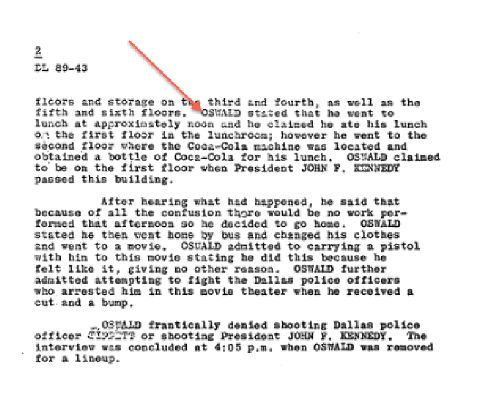 |

|
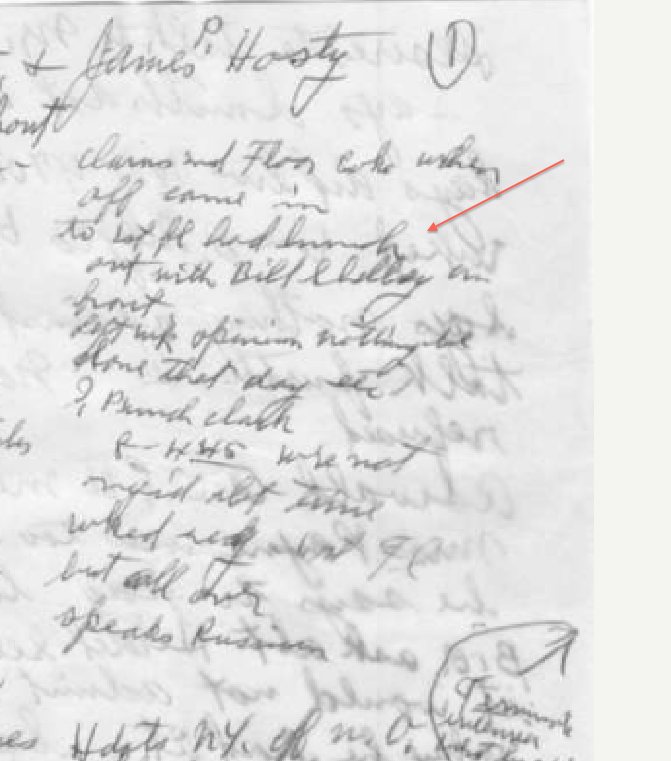
|
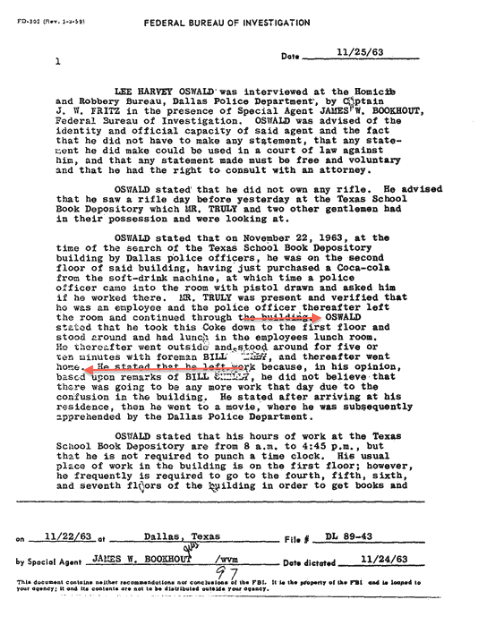
|
The
Warren Commission decided to ignore Sandra Styles and Dorothy Garner,
and focus their attention on Victoria Adams. They concluded that Adams
was simply mistaken as to the time she ran down the stairs. The
Commission instead accepted and relied upon the testimony of Bill
Shelley and Billy Lovelady, who said that after the shooting they
walked to the railroad tracks, walked around the west side of the
building, and then re-entered the TSBD 5-10 minutes later. They ignored
US attorney Martha Stroud's letter concerning Dorothy Garner, and
concluded that Adams began walking down the stairs only after Baker and
Truly had confronted Oswald in the lunchroom. The Commission also
concluded that Adams then may have seen Shelley and Lovelady on the
first floor, but 5-10 minutes after the shooting.
How the Warren Commission solved the 2nd
problem:
co-conspirators (LEE) Oswald, Shelley, and Lovelady
The 2nd problem. The
fact that two "white men" were at the back of the TSBD within one
minute after shots were fired was well known to the Warren Commission
and to their attorneys. DPD Officer Marrion Baker told the Warren
Commission that when he and Roy Truly arrived on the first floor at the
back of the TSBD, only moments after the shooting, he saw two unknown
men. One of these men was standing near the stairs (access to the 6th
floor) and the other man about 20-30 feet away (near the electrical
panels). WC member Allen Dulles asked Baker, "Were they white men?"
Baker replied, "Yes." Victoria Adams knew both of these men, and told
the Warren Commission that she saw Bill Shelley and Billy Lovelady on
the first floor about one minute after the shooting--only moments
before Baker and Truly arrived at the back of the TSBD. Adams'
testimony suggested a conspiracy, by linking shooter(s) from the sixth
floor (running down the stairs to the 1st floor) with Shelley and
Lovelady (waiting by the stairs on the 1st floor)--only one minute
after the shooting. Adams, however, did not understand the
implications or seriousness of what she had seen and experienced.
On the day of the shooting Bill Shelley gave an affidavit to the Dallas
Police Dept. Shelley said that after the shooting, "I went back to
the building & went inside
& called my wife & told her what happened. I was on the first
floor then & I stayed at the elevator & was told not to let
anyone out of the elevator." Five months later W.C. attorney Joseph
Ball asked Bill Shelley, "Did you ever see Vickie Adams?" Mr. Ball
knew, and could only have known from Adams' testimony taken that
morning, that she saw and identified the two men seen by Baker
definitely as Bill Shelley and probably Billy Lovelady at the back of
the TSBD within one minute of the shooting. Shelley answered, "I
saw her that day but I don't remember where I saw her." Mr. Ball, "You
don't remember whether you saw her when you came back?" Shelley
answered, "It was after we entered the building." Mr. Ball, "You think
you did see her after you entered the building?" Shelley, "Yes, sir; I
thought it was on the fourth floor awhile after that." Shelley,
like Lovelady, is now claiming that he "may" have seen Victoria Adams
but much later and he can't remember where or when he saw her. Mr.
Ball, "Did you see Vickie Adams after you came into the building and
did you see her on the first floor?" Shelley answered, "I sure don't
remember." The only reason for Mr. Ball to ask Shelley if he saw
Victoria Adams on the first floor was in response to Adams' testimony
that she saw and spoke to Shelley on the first floor within one minute
of the shooting.
On the day of the shooting Billy Lovelady gave an affidavit to the
Dallas Police Dept. Lovelady said, "After it was over we went back into
the building and went to work took some police
officers up to search
the building." W.C. attorney Ball asked Billy Lovelady, "Who did you
see in the first floor?" The only reason for Mr. Ball to ask Lovelady
if he saw someone on the first floor was in response to Adams'
testimony that she saw Lovelady on the first floor within one minute of
the shooting. Lovelady replied, "I saw a girl but I wouldn't swear to
it it's Vickie." How did Lovelady know to answer with the name "Vickie"
when her name hadn't been mentioned during Lovelady's previous
testimony or questioning? Ball then asked, "Who is Vickie?" Lovelady
said, "The girl that works for Scott, Foresman." Lovelady can't
swear that he saw Vickie, yet he knows that Vickie works for Scott,
Foresman??
Neither Baker nor Truly provided any information to the Commission as
to the two unknown "white men" seen at the back of the TSBD within two
minutes of the shooting. Shelley and Lovelady's testimony, in April,
1964, was accepted by the Commission. The Commission concluded that
Shelley and Lovelady were outside of the TSBD during and after the
shooting, and only returned to the building 10 minutes later. The
Commission concluded that during this time (HARVEY) Oswald was running
from the sniper's nest to the 2nd floor lunchroom.
How the Warren Commission solved the 3rd
problem: electrical
service shut off during the shooting
The
Warren Commission knew the electricity had been shut off minutes before
the shooting and turned back on minutes after the shooting. This is not
only very suspicious but suggestive of a conspiracy. The Commission had
photographs of the electrical panels on the first floor and knew there
were two "white men" nearby about one minute before and 1 1/2 minutes
after the shooting. Why was the Commission not interested to learn the
identity of these two men, who were at the back of the TSBD near the
electrical panels and near the only means of escape from the the 6th
floor only 1 1/2 minutes after the shooting? Why did the Commission
fail to ask Roy Truly if he knew either of these men? Or ask Officer
Baker to confirm or deny these two men were Bill Shelley or Billy
Lovelady? Because
the Commission's assignment was to conclude that one man, Lee Harvey
Oswald, shot and killed President Kennedy---with no accomplices.
So, how did the two men on the 6th floor leave the
building?
It is, and probably always will be, impossible to "prove" how two men
managed to enter and then leave the 6th floor without being seen or
heard by anyone. But escaping from the 6th floor thru the passenger
elevator shaft, with the help of TSBD employees/accomplices, is quite
easy and could explain why the electricity was briefly turned off
minutes before the shooting and turned back on about two minutes after
the shooting. Escaping thru the elevator shaft could explain why
Jarman, Norman, Williams, Styles, Adams, Garner, Dougherty, Truly, and
Baker neither saw nor heard anyone either on the 6th floor, neither
heard nor saw anyone running down the old, wooden stairway or riding
down on the freight elevators.
Entering the elevator shaft from the 6th floor and climbing into the
elevator cabin could only be done if the passenger elevator was stopped
on the 4th floor. Shutting off the electricity and stopping the
passenger elevator on the 4th floor could explain the presence of Billy
Lovelady on the first floor moments before the motorcade arrived.
Turning the electricity back on to activate the passenger elevator,
about two minutes after the shooting, could explain both Shelley and
Lovelady's presence on the first floor at the back of the building
where they were seen by Victoria Adams. Their unexplained presence at
this location within a minute of the shooting, and Roy Truly's failure
to acknowledge them, identify them to Officer Baker, or to ever mention
them to anyone
is also a good indication that Truly may have been a co-conspirator.
Truly was the man responsible for hiring HARVEY Oswald only weeks
before the assassination, placing him in the TSBD on 11/22/63, and
telling police that Oswald was the only employee unaccounted for within
minutes of the shooting.
Victoria Elizabeth Adams

After
relocating to Chicago in 1964 Victoria Adams' life returned to normal,
but she constantly thought about her turbulent time in Dallas. She told
author Barry Ernest, "Remember, I was a very young woman at the time
and believed in my government. Because of the strange circumstances and
discounting of my statements, my multiple questioning by various
government agencies and the Warren Commission's conclusions, I
lost my starry eyed beliefs in the integrity of our government. And I
was scared. I was a young lady alone with no family or friend support
at the time. Perhaps you can imagine the state of mind of a young lady
in her 20's who had been frightened about many things.... When that
Dallas detective lied to me (about the fire), I knew something wasn't
right... But the faith loss actually hit it's finality when my
testimony was discounted and I knew someone was trying to fit a puzzle
together with lots of pieces from some other puzzle they had and create
a story they wanted the public to believe.... I felt like a fool, an
idiot whose credibility would be challenged from that point on. I had
been disparaged and felt ridiculed and minimized. This truly shook me
to my core.... I'm sure you can't imagine the feelings that coursed
through me as I realized the possibilities of what was going on. I am
convinced there was something funny going on.... Both Sandra and I were
very nervous about the whole thing since we knew we had been where the
killer reputedly was at approximately the same time. I cannot say much
about what I believe happened, but I do suspect that Oswald was never
on the sixth floor at the time of the assassination. I actually think
the Warren Commission needed to bring an end to the investigation. I
must say it was a great relief when I was offered a job at the Scott
Foresman home office in Chicago."
In Chicago Adams met and married a man from a suburb, left the city in
1966, and moved to San Diego, CA. Thoughts of Dallas still haunted
Vickie, but she returned to college, acquired a degree in general
education, and graduated with honors. She had her first child in 1970.
In 1974 Vickie became involved with real estate, while continuing her
education at night, obtained a bachelor's degree in business
administration. and graduated summa cum laude. Her accomplishments and
career in business was acknowledged by Who's Who of American Women
(a biographical dictionary of notable living American women) and Who's
Who in the World (concise, accurate biographies of renowned individuals
from around the world).
A couple of years later Vickie and her husband traveled around the
country in a five wheel trailer for the next 6 years. Her husband had
become an avid reader of all JFK related material, and convinced Vickie
that she should remain quiet about her background. Too many people were
dying and it would be much safer if she kept quiet. Victoria followed
her husband's advice.
February, 2002--Barry Ernest contacts Victoria
JFK
researcher Barry Ernest contacted Ms. Adams in 2002, almost 40 years
after the tragic events of 11/22/63. She was 61 years old and living on
the west coast. She told Ernest, "I saw what I saw and my testimony
apparently didn't fit what the government wanted...What I said was
true. I said it so many times I got tired of saying it.... Repeatedly I
asked that my testimony be confirmed by another witness who was with me
part of the time, but I was basically thrown off....They literally
wanted to hang the murder on someone and do it quickly to stop the
truth from being known, whatever the truth really was.... Things kind
of died around it and I just gave up.... My husband is bored by the
topic, and I had no desire to read someone's opinion of what happened
when I was actually there and indirectly participated in the events of
the day.
Ernest asked Ms. Adams if this was the first time she had provided
particulars to anyone. She answered, "Absolutely." Ernest knew that
Adams told the W.C. that she saw and briefly spoke with William Shelley
and Billy Lovelady on the first floor. When he began to ask Ms. Adams
about this she replied, "They weren't there.... I honestly can't
remember seeing them (on the first floor)... No, they weren't there."
When asked if she knew these two men she replied, "Not at all, except
to see them around.... How could I have seen them on the first floor
anyway if they were outside the building for that long." Ernest noted,
and wrote in his book, "Ms. Adams was clearly uneasy about this
matter."
In 2002, nearly 40 years after being interviewed by DPD detective
Lavelle, testifying before the Warren Commission, signing and making
corrections to her transcribed deposition, she told JFK
investigator/author Barry Ernest that she never saw Shelly or Lovelady
on the first floor. It took Shelly and Lovelady five months to change
their stories--from returning to the 1st floor of the TSBD
immediately after the shooting to remaining outside of the TSBD for
5-10 minutes after the shooting. It took Adams nearly 40 years to
change her story.
Let's take a few minutes to review the historical details
and consider Adams' new story as of 2002....
- Within a half-hour of the assassination Bill Shelley and Billy
Lovelady were taken to DPD headquarters and gave signed affidavits
stating that immediately after the shooting they went to the rear of
the TSBD on the first floor, they stayed by the freight elevators, and
then accompanied police as they searched the upper floors of the TSBD.
Shelley was then photographed as he, Danny Arce, and Bonnie Ray
Williams were escorted by police to a squad car and driven to police
headquarters. It is extremely doubtful that Shelley and Lovelady
left the TSBD after the shooting, walked to the railroad tracks, and
then re-entered the TSBD 5-10 minutes later.
- Adams saw Shelley and Lovelady on the first floor about one
minute after the shooting, as recorded in DPD detective James
Leavelle's interview of Adams in February, 1964.
- Adams' W.C. testimony, about seeing Shelley and Lovelady on the
first floor one minute after the shooting, was recorded on April 7,
1964.
- Shortly after giving testimony to the W.C., Adams read her
deposition, made corrections, and signed the document. This careful,
accurate, intelligent woman read and sign this document wherein she
testified to seeing Shelley and Lovelady on the 1st floor the TSBD one
minute after the shooting. This document was classified "TOP
SECRET" for the next 30 years.
- By testifying that she saw Shelley and Lovelady on the first
floor within one minute of the shooting, the W.C. attorneys become
acutely aware of a serious "timing problem," which is why her corrected
and signed W.C. testimony was classified "TOP SECRET."
- The WC failed to interview supervisor Dorothy Garner, who stood
by the 4th floor stairway and watched Adams and Styles run down the
stairs, watched Truly and Baker as they ran past her and up to the 5th
floor, and neither heard nor saw anyone else on the stairway.
- The
W.C. deposed Victoria Adams (2:15 PM), Billy Lovelady (3:50 PM), and
Bill Shelley (4:10 PM) all on the same day--April 7, 1964. The only way
that W.C. attorney Joseph Ball knew to ask both
Shelley and Lovelady if they saw Vickie Adams on 11/22/63 was because
of her testimony, taken only two hours earlier.
Ball's asking Shelley and Lovelady about Vickie Adams is proof that
Adams told the WC that she saw Shelley/Lovelady on the first floor
within one minute of the shooting, which was recorded in her W.C.
testimony. Without Adams/ testimony, attorney Ball would have no
reason to ask Shelley/Lovelady about Vickie Adams--only a couple of
hours later.
- WC counsel Wesley Liebeler read Adam's W.C. testimony and
wrote, "Victoria Adams testified that she came down the stairway,
within about 1 minute after the shots, from the fourth floor to the
first floor where she encountered two Depository employees--Bill
Shelley and Billy Lovelady." If Adams saw these two men on the 1st
floor, near the freight elevators and stairway, only one minute after
the shooting, then how could Oswald have ran down the stairs from the
6th to the 2nd floor at the same time?
- DPD officer Marrion Baker said there were two "white men" on
the first floor, at the back of the TSBD, about 1 1/2 minutes after the
shooting. If these two men were not Shelley and Lovelady, as identified
by Victoria Adams, then who were these men? Why did the WC not bring
Baker, Shelley, and Lovelady together for the purpose of asking Officer
Baker if these were the two men he saw at the rear of the TSBD 1 1/2
minutes after the shooting? If not Shelley and Lovelady then why did
Roy Truly fail to identify either of these men to Officer Baker as
strangers? And who, if not Truly, told Bill Shelley to stay by the
elevators and not let anyone off?
- Shelley and Lovelady both changed their testimony as to their
whereabouts, immediately following the shooting, on 3 separate
occasions. Why change testimony, if not to hide their whereabouts and
activites at the back of the TSBD on the 1st floor only moments after
the shooting?
- There is no indication nor proof that Victoria Adams told
anyone, prior to talking with Barry Ernest in 2002, that she did NOT
see Shelley or Lovelady when she arrived on the first floor of the TSBD
one minute after the shooting. Forty years later she told Ernest,
for the first time, that she thinks someone added the information about
Shelley and Lovelady to her testimony.
QUESTION: If Adams' claim that someone
(FBI/WC)
had added Shelley and Lovelady's information to Adams' original
testimony, in an attempt to challenge her claim that she saw both men
on the first floor one minute after the shooting, then why does her
testimony say that she saw Shelley and Lovelady only ONE MINUTE after
the shooting? If additional testimony had been added by the FBI/WC,
then this additional testimony would have necessarily said that Adams
saw Shelley and Lovelady 5-10 MINUTES AFTER the shooting--certainly
not one minute
after the shooting! How could additional testimony have been added to
the DPD interview of Adams by James Levelle on 2/17/64? How could
information about Shelley and Lovelady have been added when Adams read,
corrected, and signed her WC testimony? WC attorney Ball became aware
of Shelley and Lovelady's presence at the rear of the TSBD one minute
after the shooting only because of Adams' WC testimony.
JFK
researcher/investigator/author Barry Ernest knew that Adams was
"clearly uneasy" when discussing Shelley and Lovelady. The question of
whether or not Shelley and Lovelady were on the 1st floor, at the rear
of the TSBD, within one minute of the shooting was crucial, and why
were they there? In 1964, five months after the shooting, both Shelley
and Lovelady say they did not return to the building for 5-10 minutes.
In 2002, nearly forty years after the shooting, Victoria Adams said she
did not see either man when she arrived on the first floor.
Barry Ernest knew that Adam's original testimony was recorded by a
court stenographer, as was the testimony of all persons interviewed by
the Commission. He traveled to the National Archives and asked to
examine the court stenographers record. Mr. Ernest was surprised and
troubled when advised that the original stenographer's records for
April 7, 1964 were missing. The only people to have access to National
Archive records are people within our Federal Government. And if
certain records disappear from the National Archives, then they
disappeared for the benefit of the government. Without the original
stenographer's record, we will never know if her WC testimony, as
recorded in the WC's 26 volumes, was accurate.
Adams died on November 15, 2007 (age 66) of cancer, so now it is up to
JFK researchers to determine the truth. Was Adams' W.C. testimony
accurately recorded and published in the W.C. volumes? Did she see
Shelley and Lovelady on the 1st floor one minute after the shooting? Or
did Adams, after 40 years of threats and intimidation, finally just
give up and say what the government wanted her to say? The decision is
yours.


![]()

